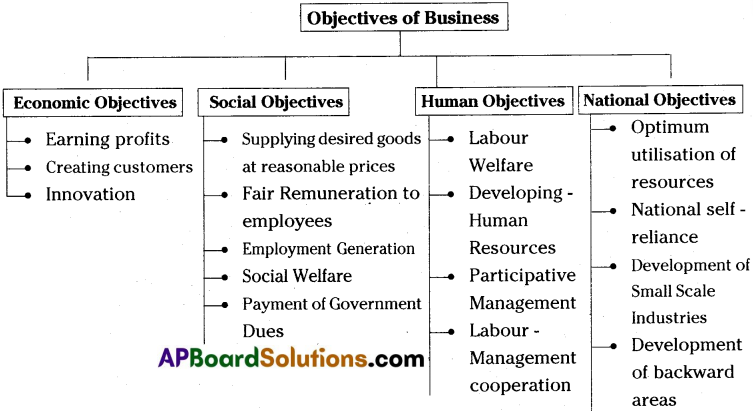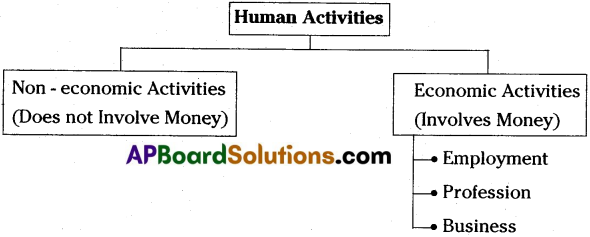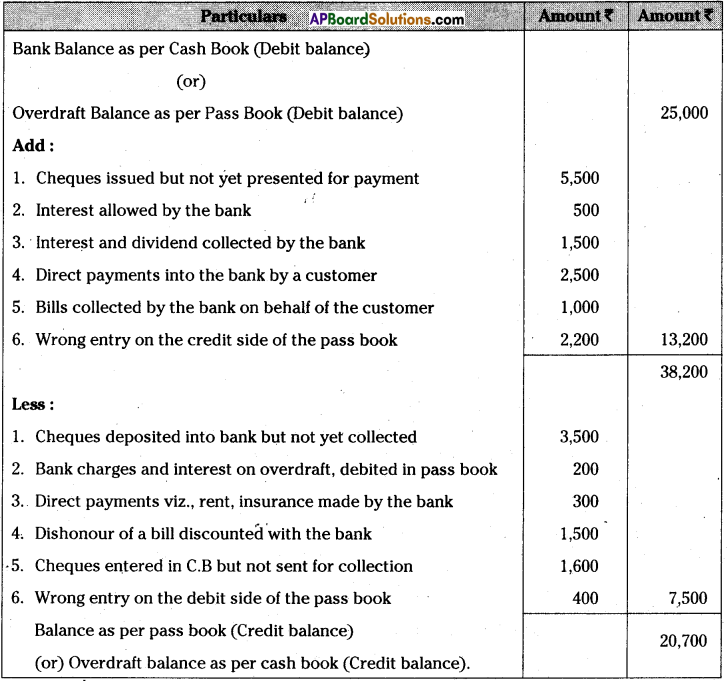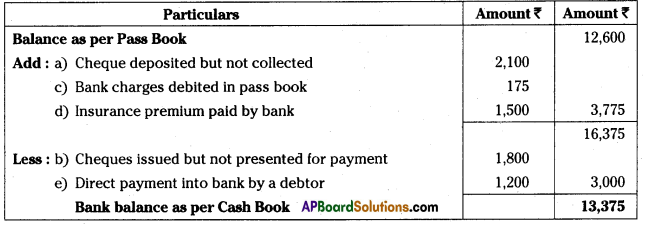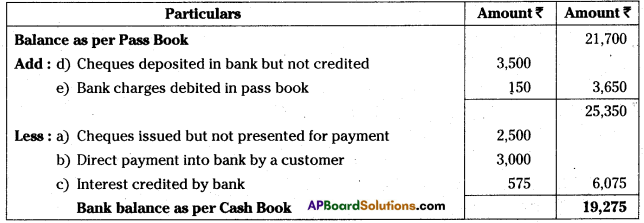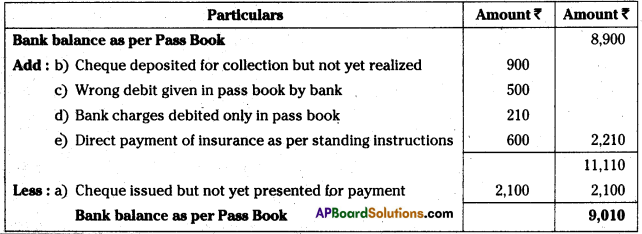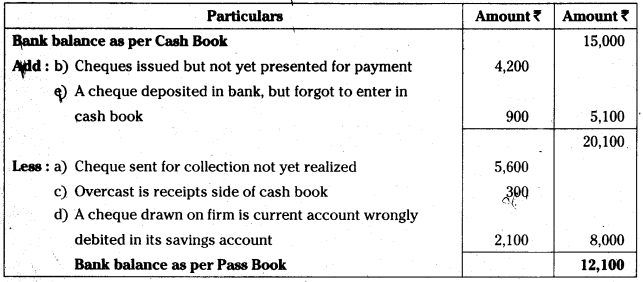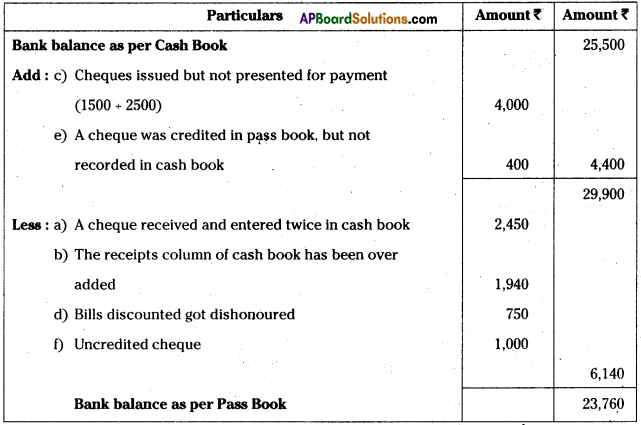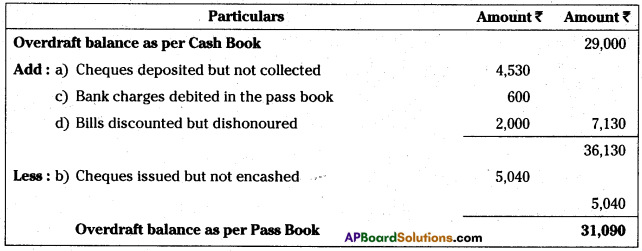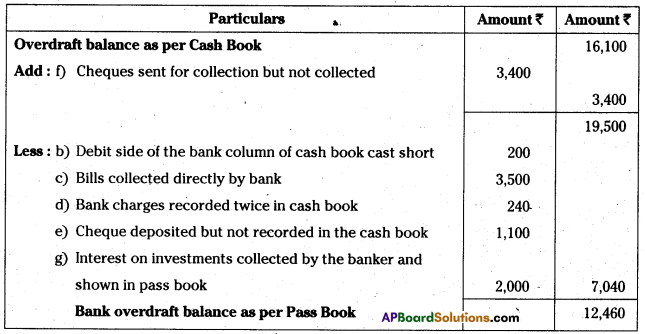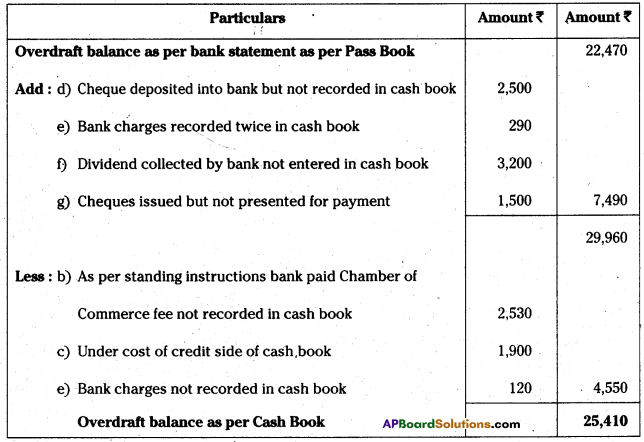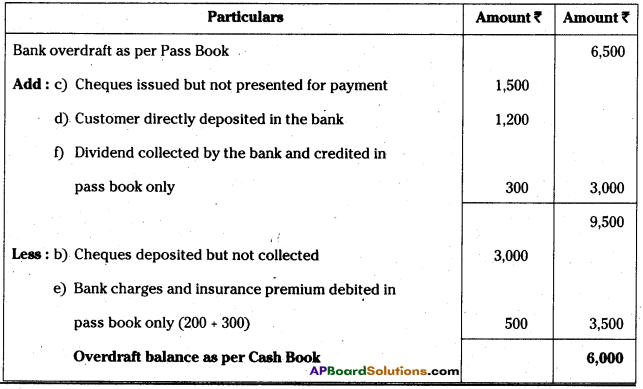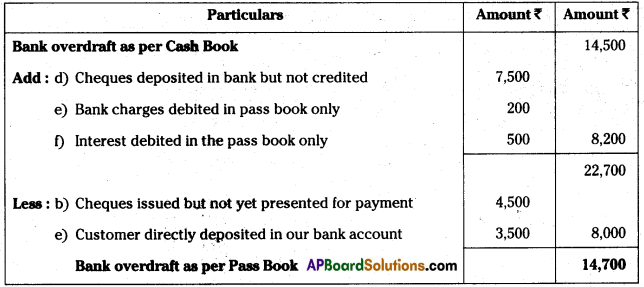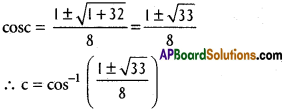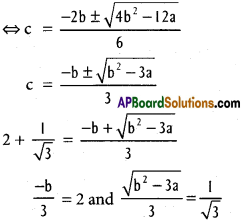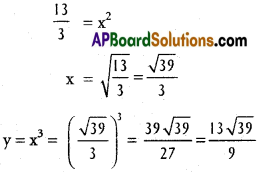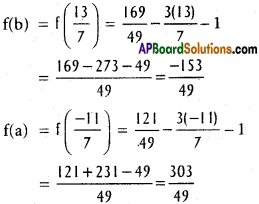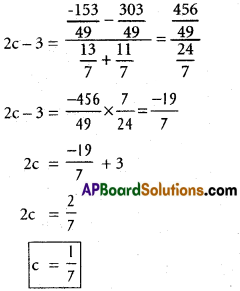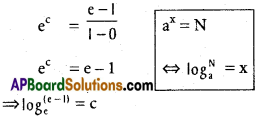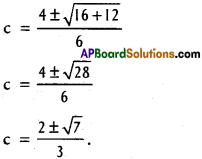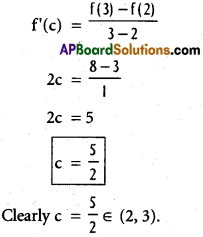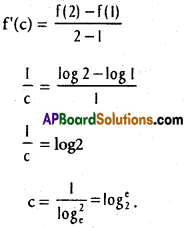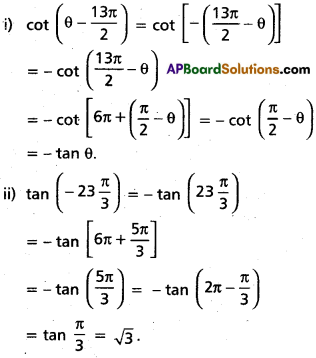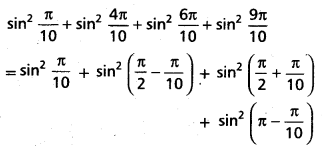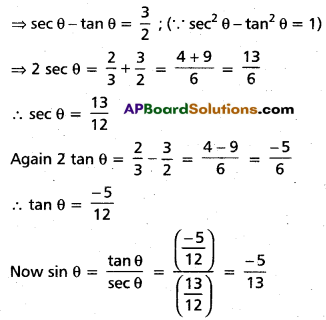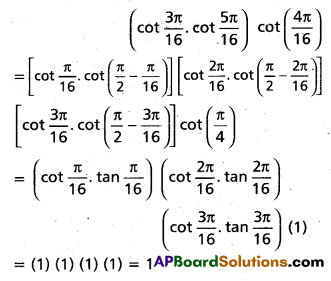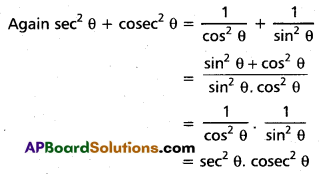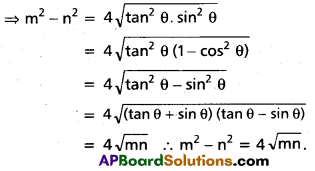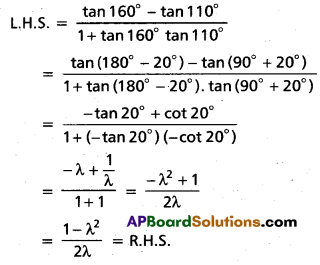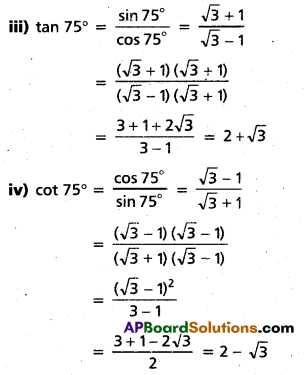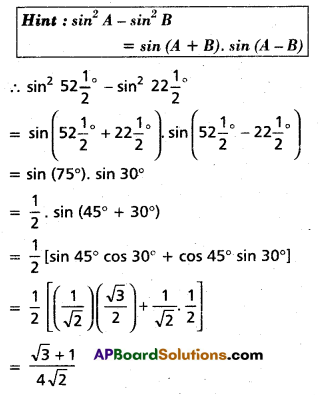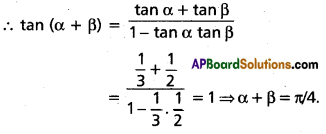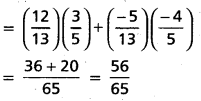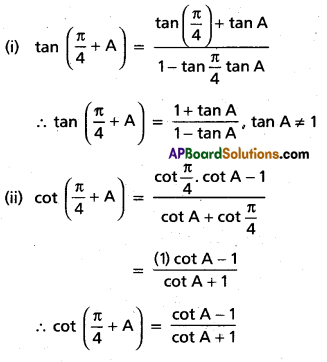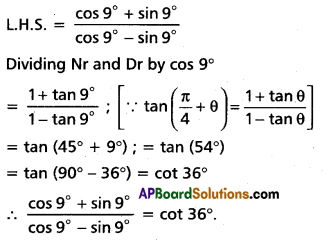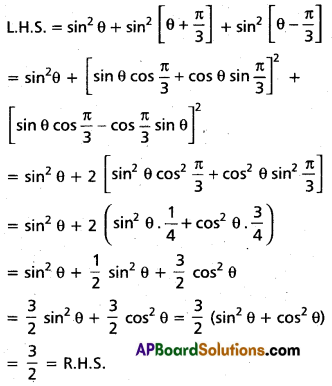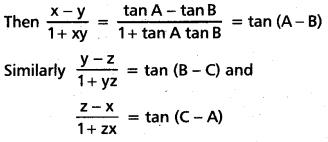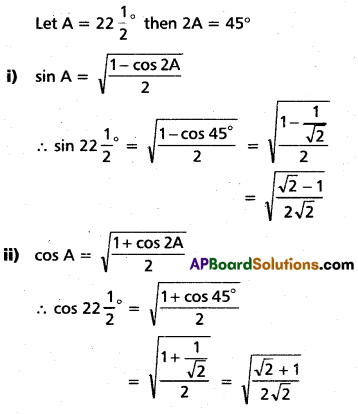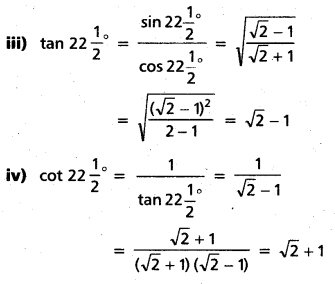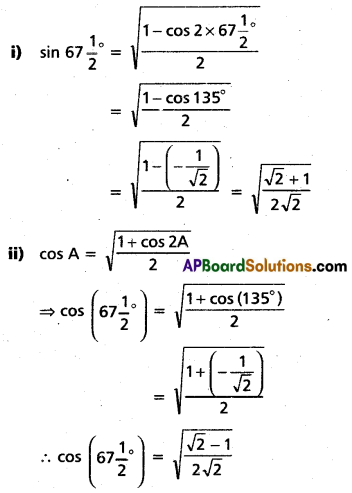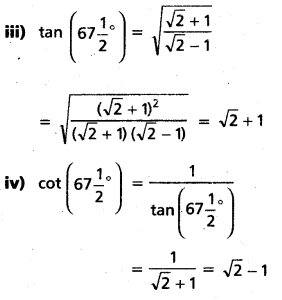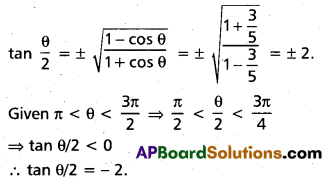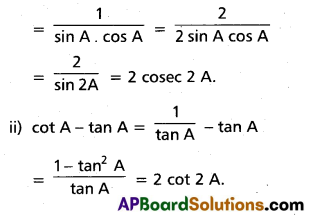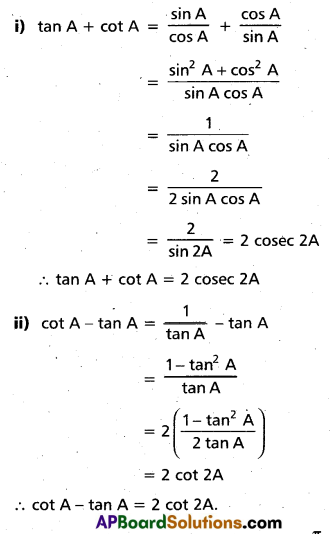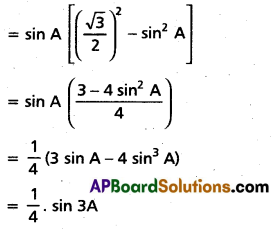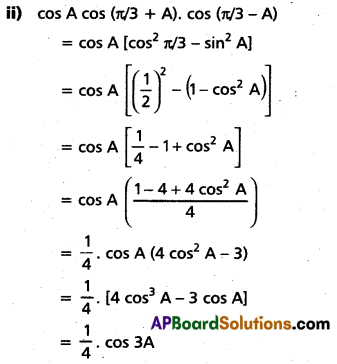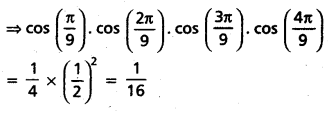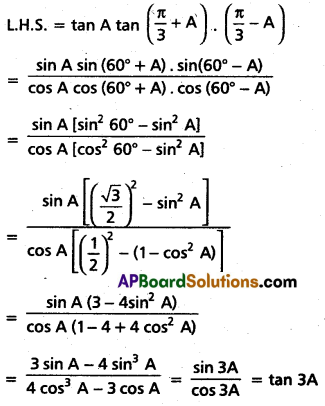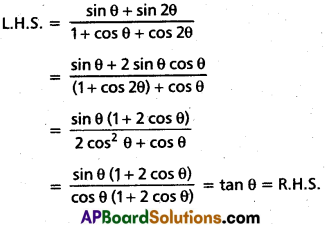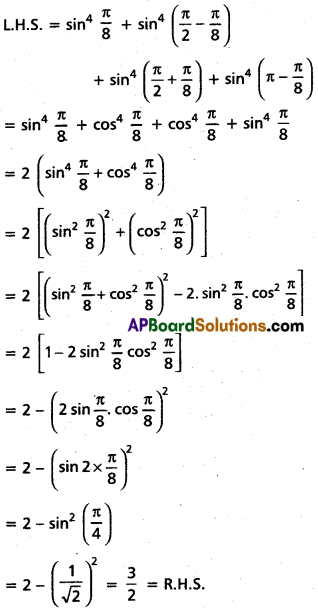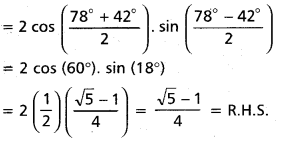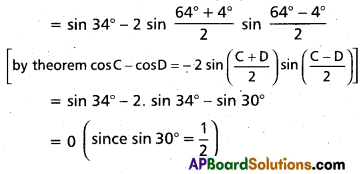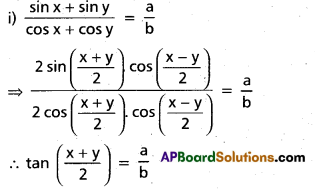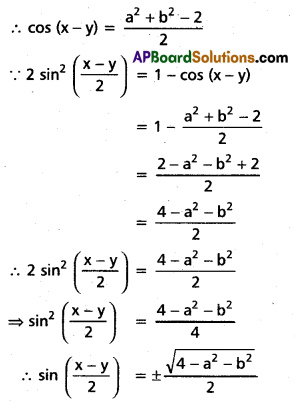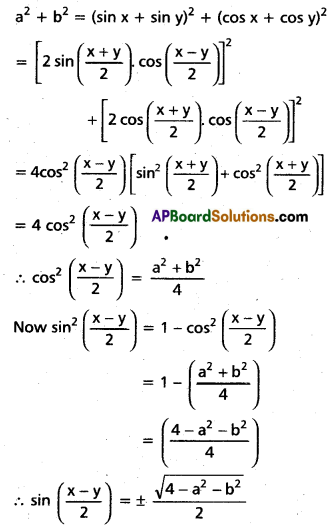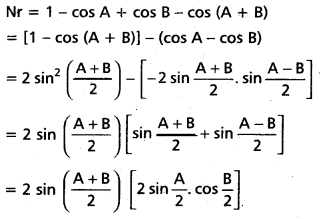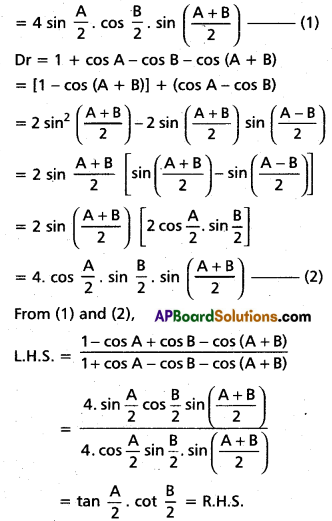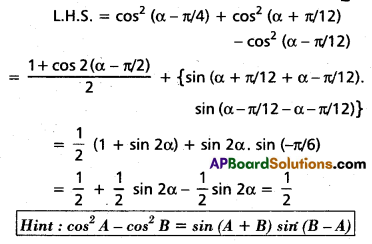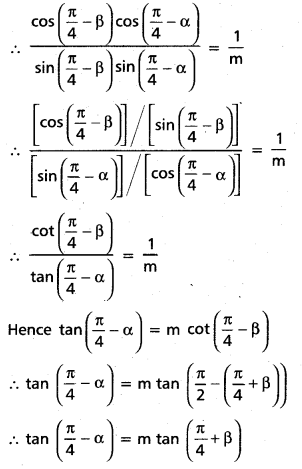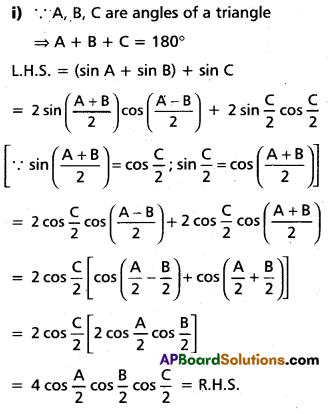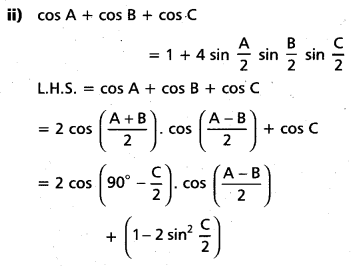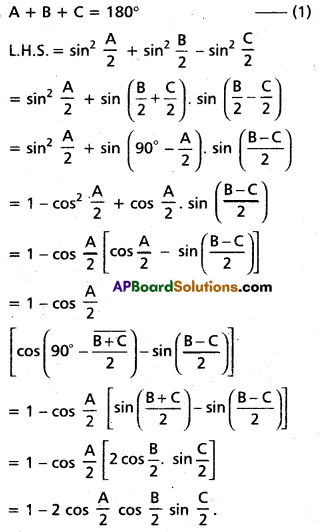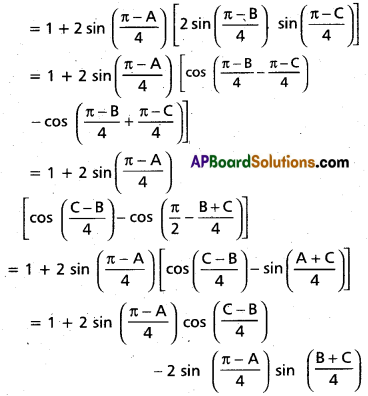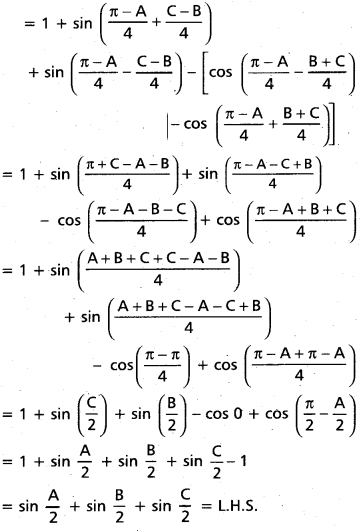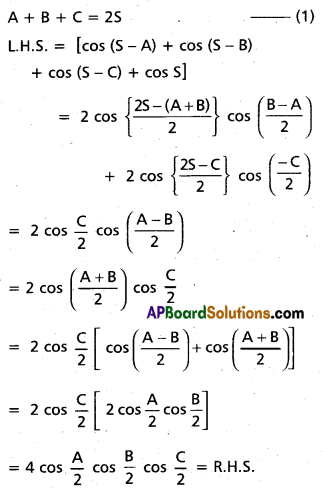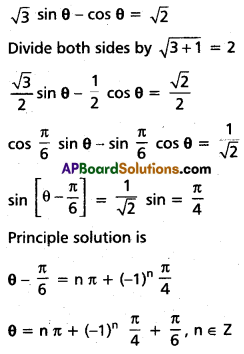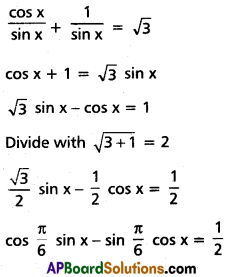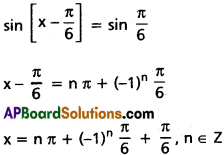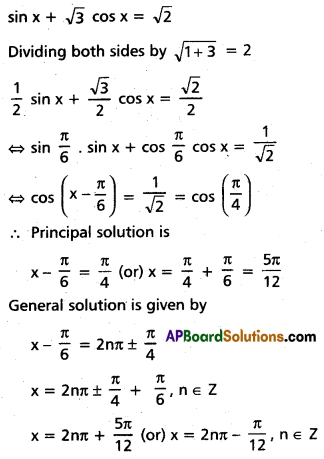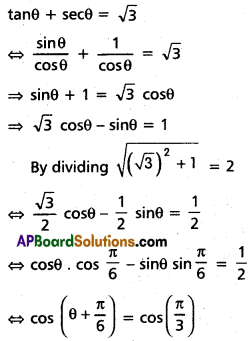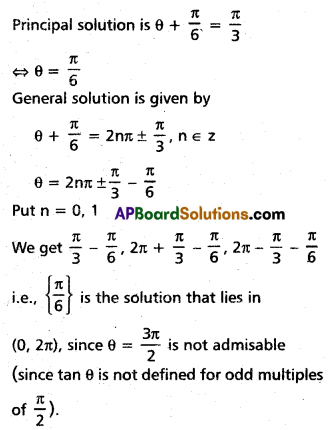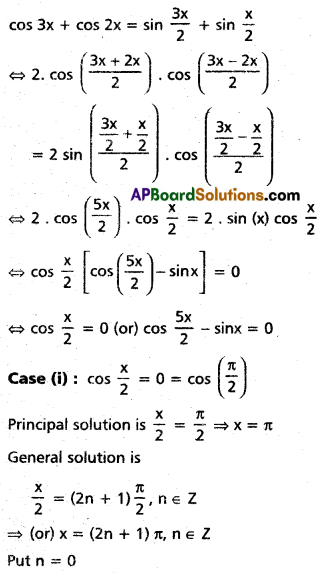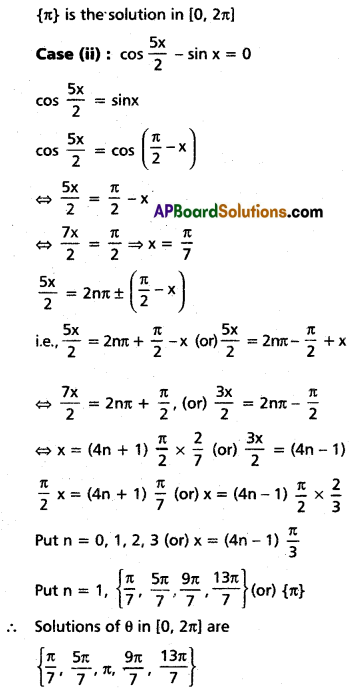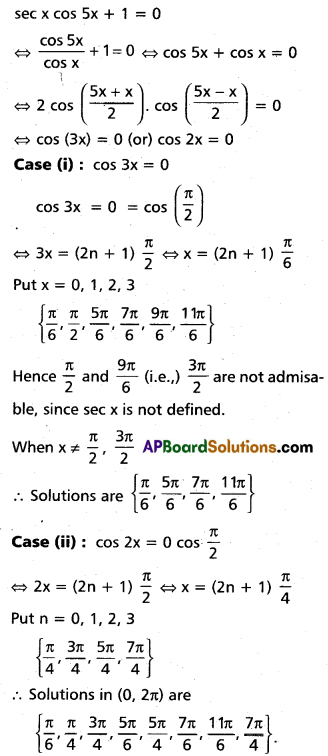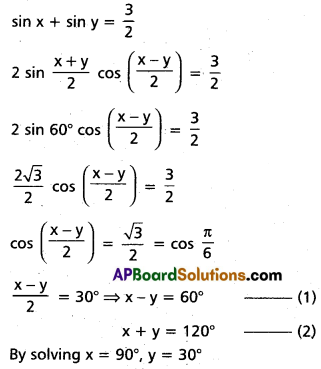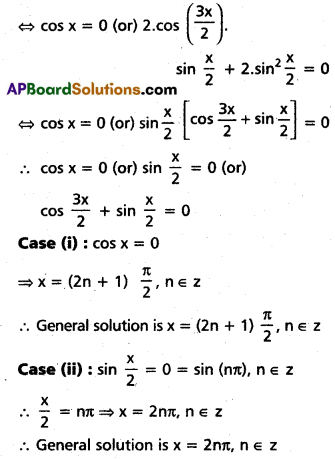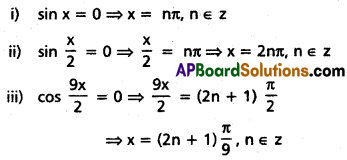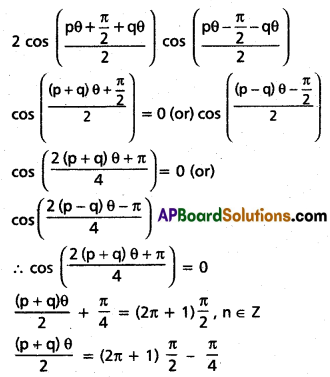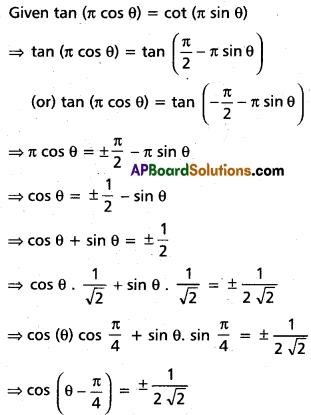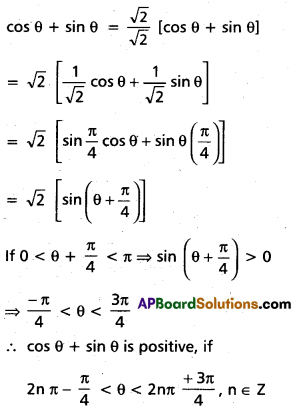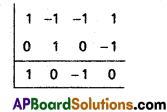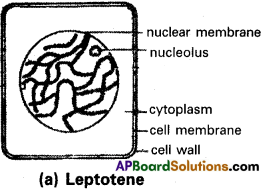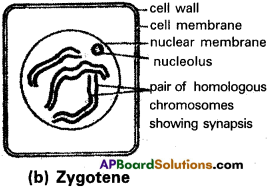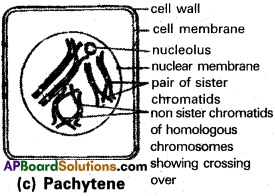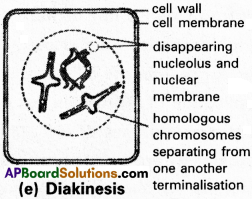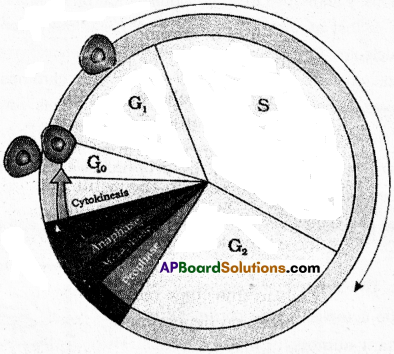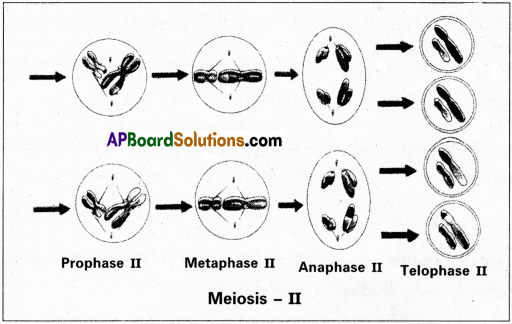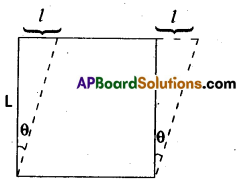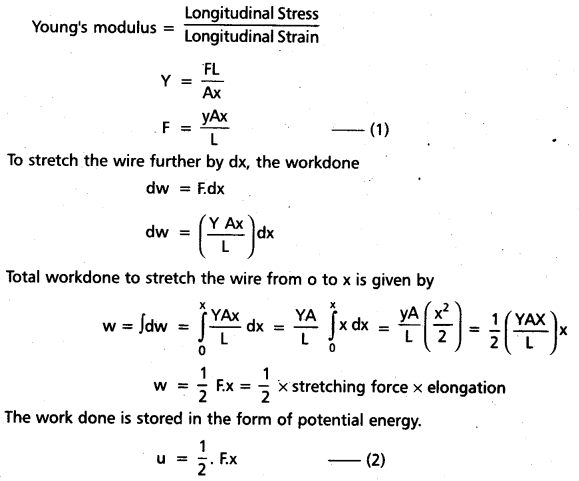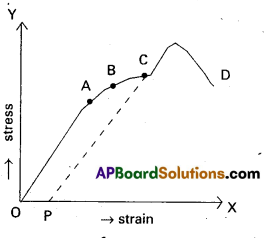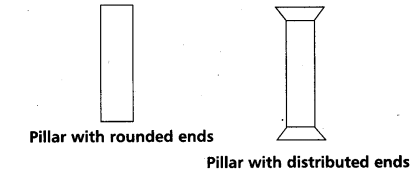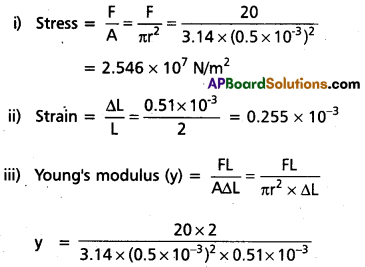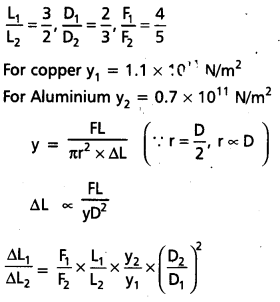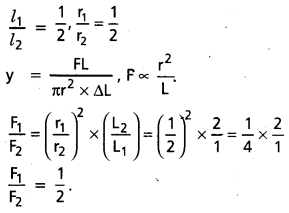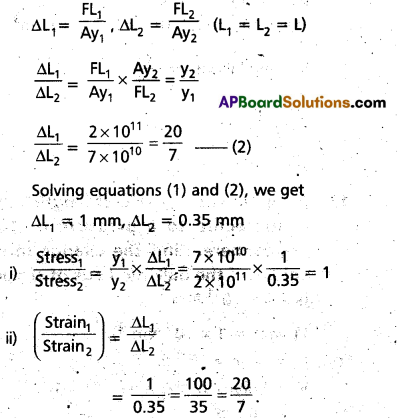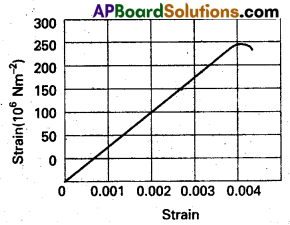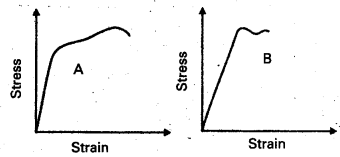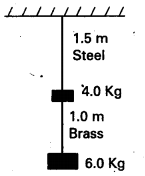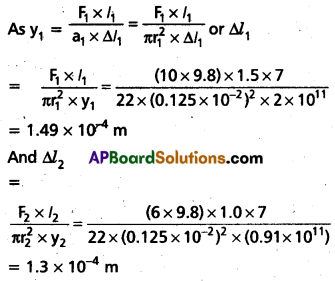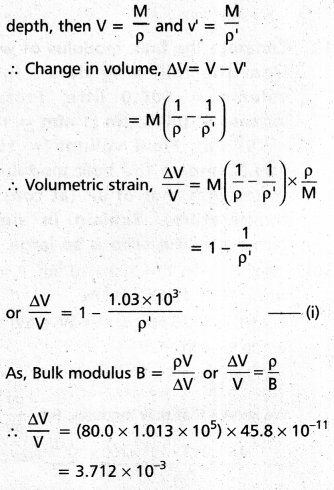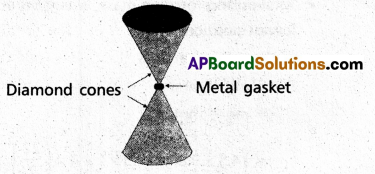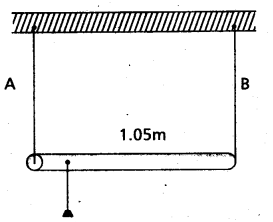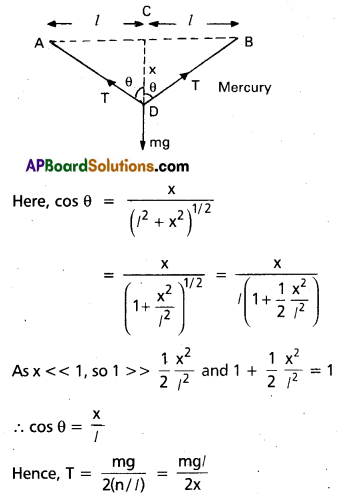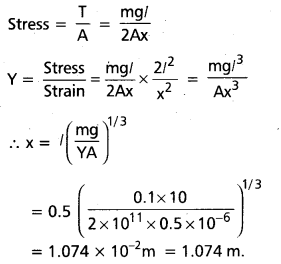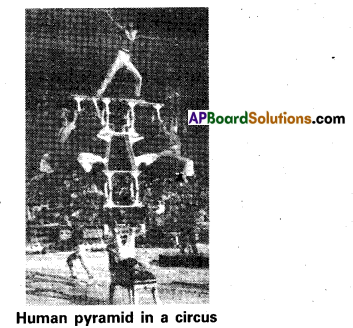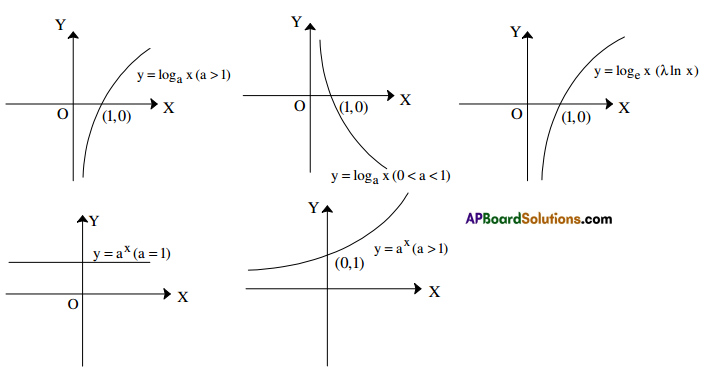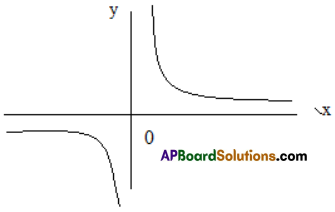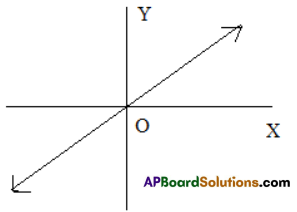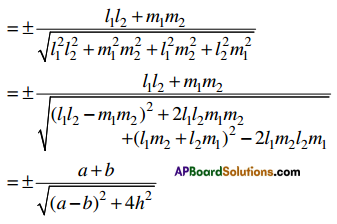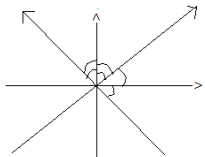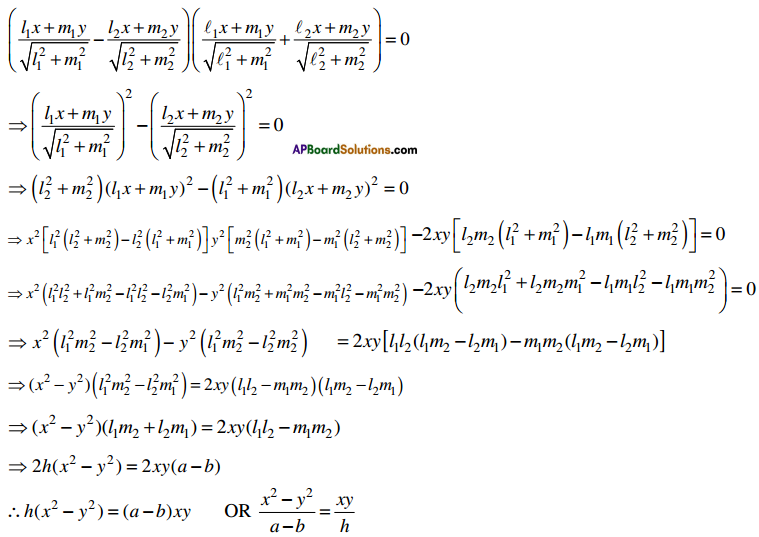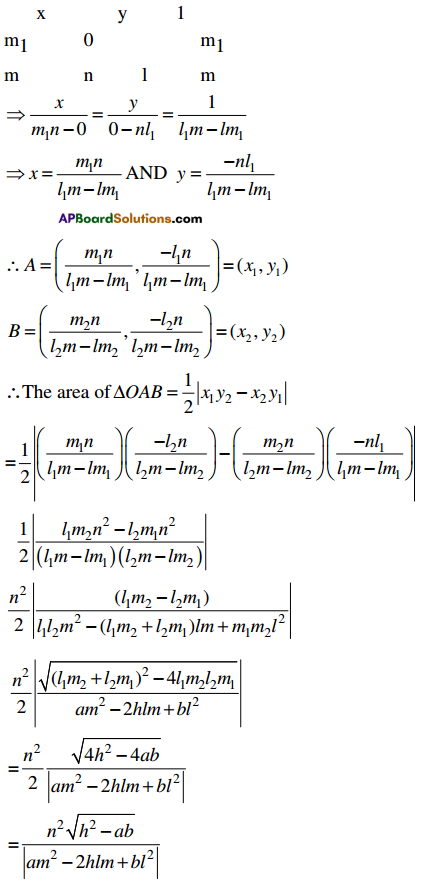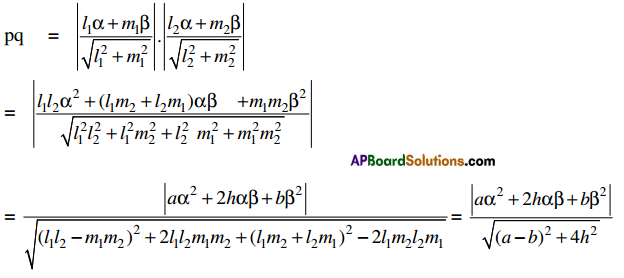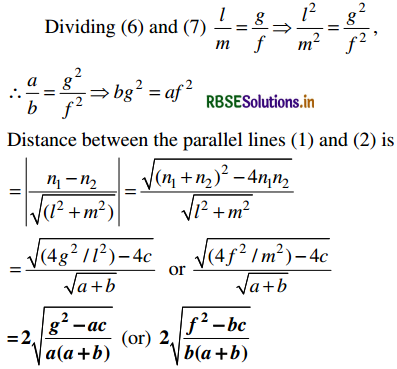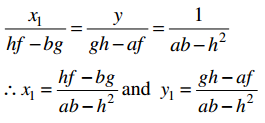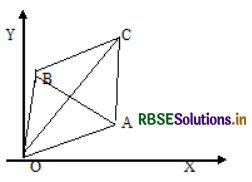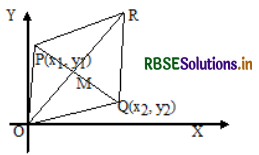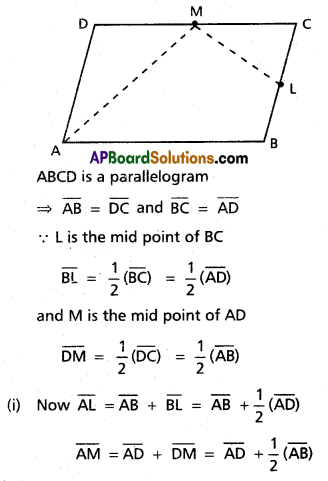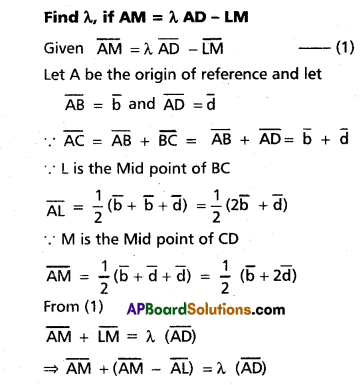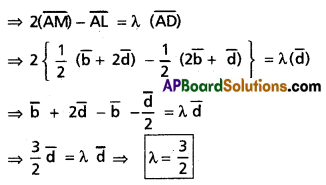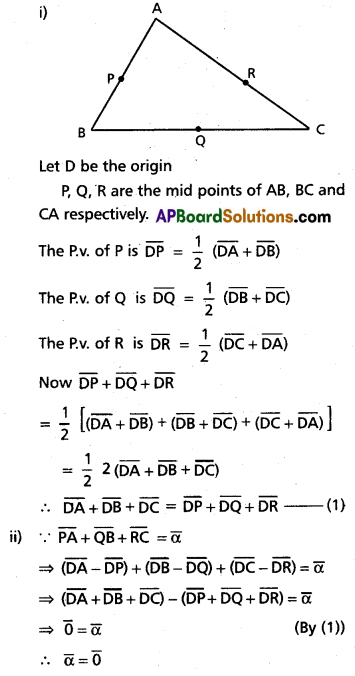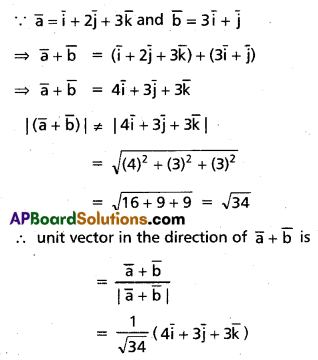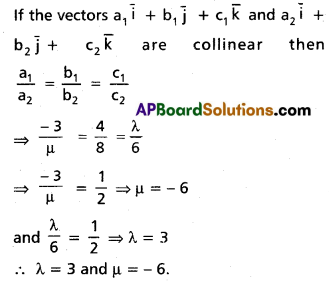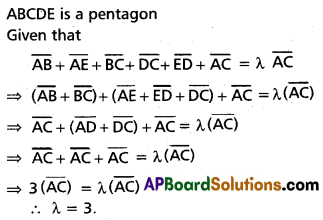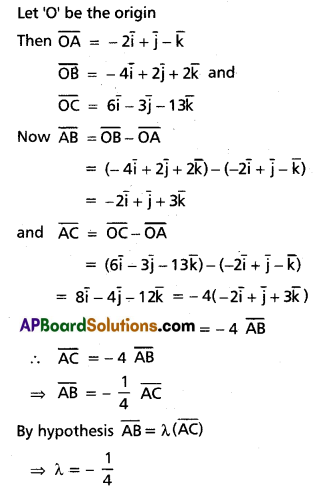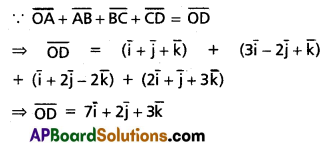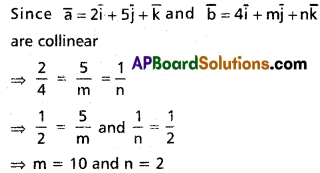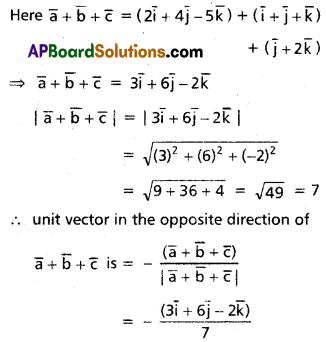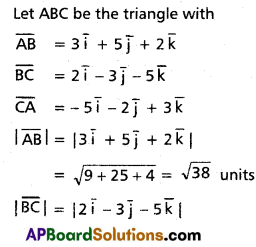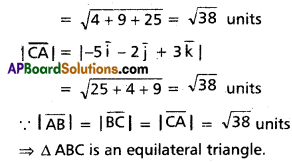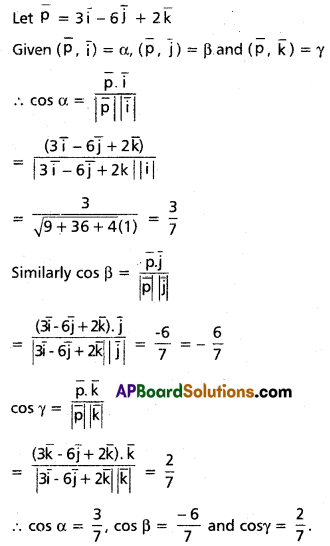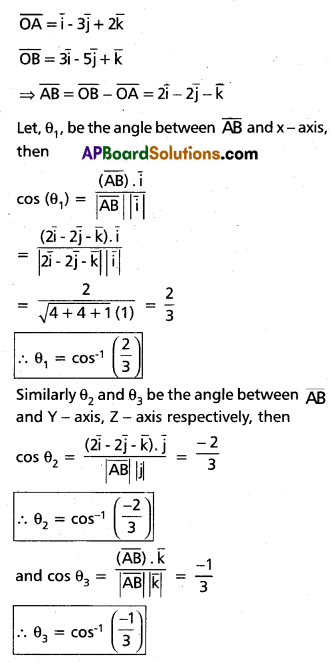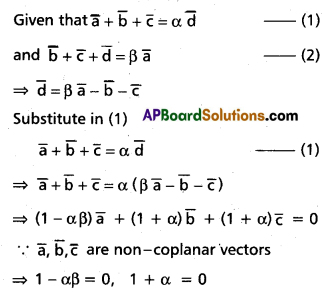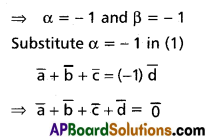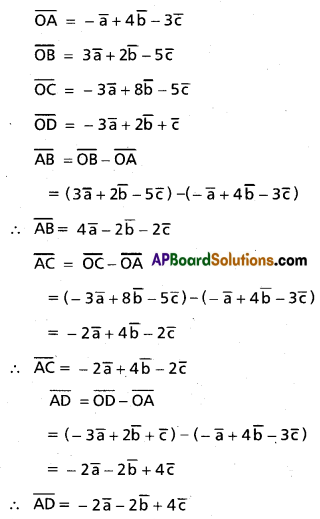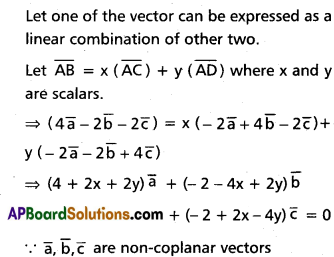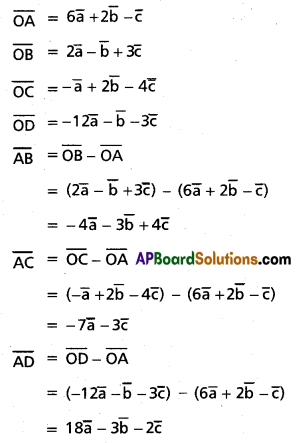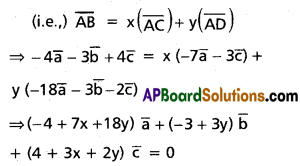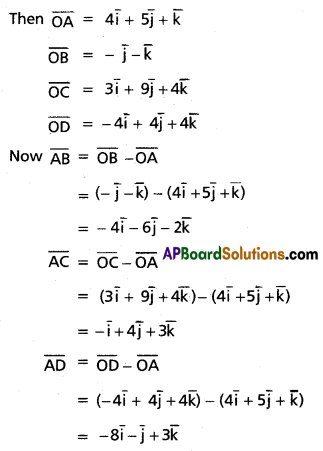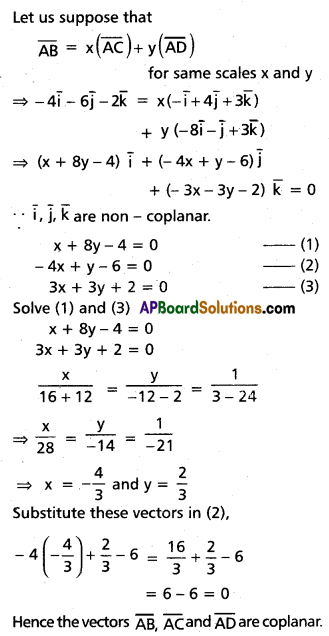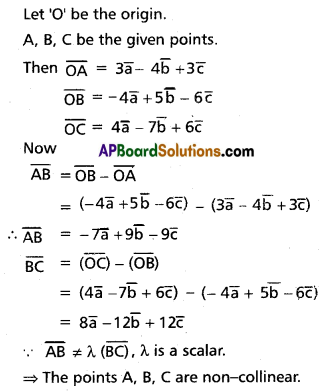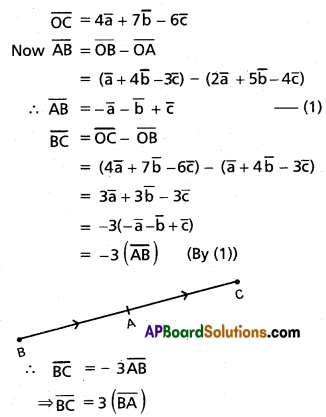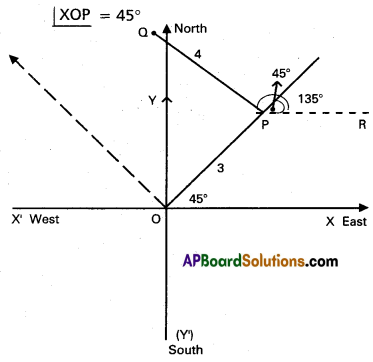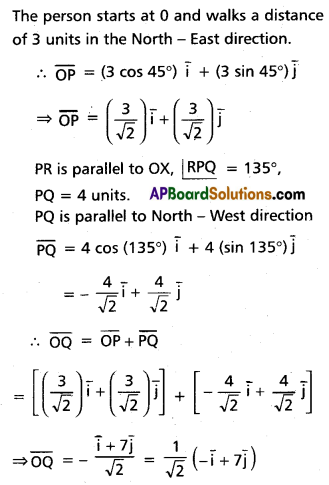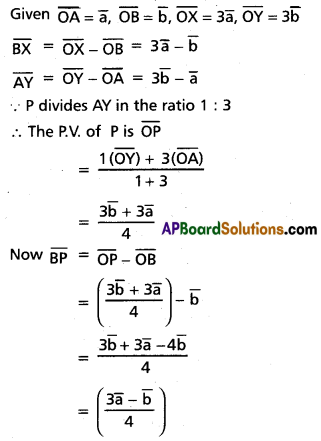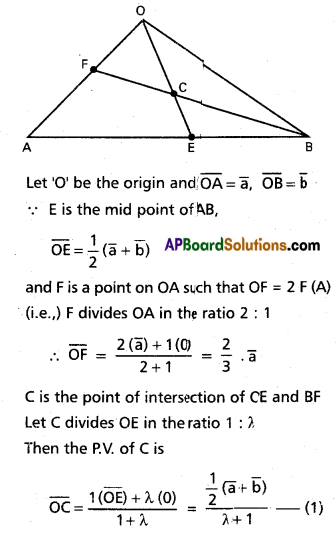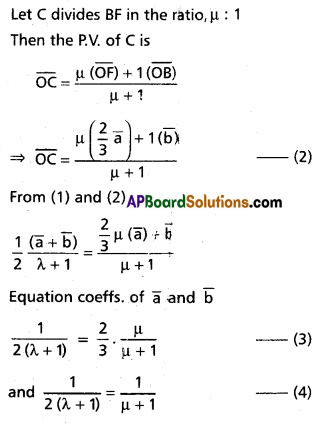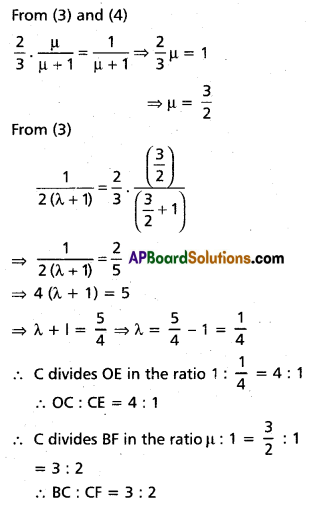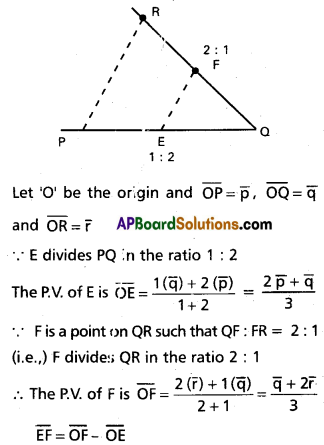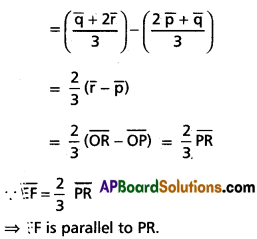Andhra Pradesh BIEAP AP Inter 1st Year Economics Study Material 3rd Lesson Theory of Demand Textbook Questions and Answers.
AP Inter 1st Year Economics Study Material 3rd Lesson Theory of Demand
Essay Questions
Question 1.
Explain the Law of Demand and examine Exceptions to it.
Answer:
Demand means a desire which is backed up by ability to buy and willingness to pay the price is called demand in Economics. Thus demand will be always to a price and time. Demand has the following features.
- Desire for the commodity
- Ability to buy the commodity
- Willing to pay the price of commodity
- Demand is always at a price
- Demand is per unit of time i.e, per day, week etc.
Therefore the price demand may be expressed in the form of small equation.
Dx = f(Px)
Price demand explains the relation between price and quantity demanded of a commodity. Price demand states that there is an inverse relationship between price and demand.
Law of demand : Marshall defines the law of demand as, “The amount demanded increases with a fall in price and diminishes with arise in price when other things remain the same”. So, the law of demand explains the inverse relationship between the price and quantity demanded of a commodity.
Demand schedule : It means a list of the quantities demanded at various prices in a given period of time in a market. An imaginary example given below.
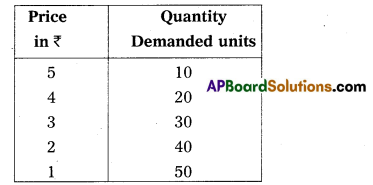
The table shows that as the price falls to ₹ 1/- the quantity demanded 50 units, when price ₹ 5/- he is buying 10 units. So, there is inverse relationship between price and demand. Price is low demand will be high and price is high demand will be low. We can illustrate the above schedule in a diagram.
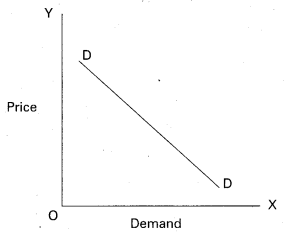
In the above diagram on X-axis demand is shown and price is on Y-axis. DD is the ad curve. Demand curves slopes downward from left to right.
Assumptions :
- No change in the income of consumer
- The taste and preferences consumers remain same.
- The prices of related goods remain the same.
- New substitutes are not discovered.
- No expectation of future price changes.
Exceptions : In certain situations, more will be demanded at higher price and less will be demanded at a lower price. In such cases the demand curve slopes upward from left to right which is called an exceptional demand curve. This can be shown in the following diagram.
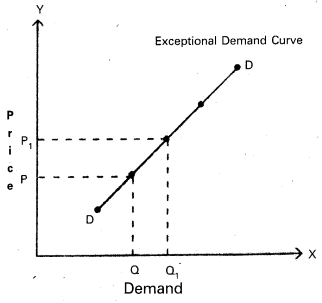
In the diagram when price increases from OP to OP1, demand also increases from OQ to OQ1. This is opposite to law of demand.
1) Giffen’s Paradox: This was stated by Sir Robert Giffen. He observed that poor people will demand more of inferior goods, if their prices raise. Inferior goods are known as Giffen goods.
Ex : Ragee, Jowar etc. He pointed out that in case of the English workers, the law of demand does not apply to bread. Giffen noticed that workers spend a major portion of their income on bread and only small portion on meat.
2) Veblen Effect (Prestigious goods) : This exception was stated by Veblen. Costly goods like diamonds and precious stones are called prestige goods or veblen goods. Generally rich people purchase those goods for the sake of prestige. Hence rich people may buy more such goods when their prices rise.
3) Speculation : When the price of a commodity rises the group of speculators expect that it will rise still further. Therefore, they buy more of that commodity. If they expect that there is a fall in price, the demand may not expand.
Ex : Shares in the stock market.
4) Illusion : Some times, consumer develop to false idea that a high priced good will have a better quality instead of low priced good. If the price of such good falls, demand decreases, which is contrary to the law of demand.
![]()
Question 2.
What is Demand Function ? What are the factors that determine the demand for a good ? [March 16]
Answer:
The functional relationship between the demand for a commodity and its various determinants may be explained mathematically in terms of a demand function.
Dx = f(Px,P1, ………… Pn, Y, T)
Where Dx = Demand for good X;
Px = price of X;
P1 …. Pn = Prices of substitutes and complementaries
Y = Income,
T = Taste of the consumer.
Determinants of demand :
- Price of commodity: The demand for any good depends on its price, more will be demanded at lower price and vice-versa.
- Prices of substitutes and complementaries : Demand is influenced by changes in price of related goods either substitutes or complementary goods.
Ex: Increase in the price of coffee leads an increase in the demand for tea in the case of substitutes positive relation and complementaries negative relationship between price and demand. - Income of the consumer : Demand always changes with a change in the incomes of the people. When income increases the demand for several commodities increases and vice-versa.
- Population : A change in the size and composition of population will effect the demand for certain goods like food grains, clothes etc.
- Taste and preferences: A change in the taste and the fashions bring about a change in the demand for a commodity.
- Technological changes: Due to economic progress technological changes the quantity the quality of goods available to the consumers increase.
Ex : Demand for cell phones reduced the demand for landline phones. - Change in the weather : Demand for commodity may change due to change in a climatic condition.
Ex : During summer demand for cool drinks, in winter demand for wollen clothes. - State of business : During the period of prosperity demand for commodities will expand and during depression demand will contract.
Question 3.
Explain the Concept of Demand and various types of Demand.
Answer:
The concept of demand has immerse significance in economics. In general language demand means a desire but in economics the desire backed up by ability to buy and willingness to pay the price.
Types of demands :
The demand may be classified into 3 types.
- Price demand
- Income demand
- Cross demand
1) Price demand : Price demand explains the relation between price and quantity demanded by a commodity it shows the inverse relationship between price and demand when the other things like consumers income, taste etc., remains constant. It means the price falls demand extends and the price raises demand contracts. The price demand can be expressed Dx = f(Px).
whereDx = Demand for X commodity
Px = Price of X
F = Function.
2) Income demand: It explains the relationship between consumers income and various quantities of various levels of income assuming other factors like price of goods, related goods, taste etc; remain the same. It means if income increases quantity demand increases and vice versa. This can be shown in the following form.
Dx = F(Y)
Where Dx = demand of X good;
Y = income of consumer.
3) Cross demand: It refers to change in demand for a commodity as a result of change in prices of its related commodities when other factors remains constant. This can be shown
Dx = f(Py)
Dx = demand of X good;
Py = Price of Y commodity;
F = function
Related goods are 2 types,
- Substitutes : Goods which satisfy same want called substitutes.
Ex : Coffee and tea. Here there is a positive relation between price and demand. - Complementary goods : These goods which satisfy the same want jointly.
Ex : Car and petrol, shoes and sockes etc; are complementary goods.
Here there exists inverse relation between complementary goods.
![]()
Question 4.
Explain the three Forms of Demand with suitable diagrams.
Answer:
The concept of demand has great significance in economics. In general language demand means a desire but in economics the desire backed up by ability to buy and willingness to pay the price.
Types of demand : The demand may be classified into three types.
- Price demand
- Income demand
- Cross demand
1) Price demand : Price demand explains the relationship between price and quantity demanded of a commodity it shows the inverse relationship between price and demand when the other things like consumers income, taste etc., remains constant. It means the price falls demand extends and price raises demand contracts. The price demand can be expressed Dx = f(Px)
Price demand can be explained with the help of demand schedule.
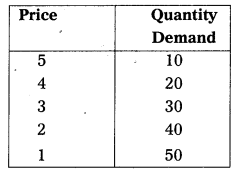
As price falls to ₹ 1/- the quantity demand is 50 units, when price of apple is ₹ 5/- he is buying 10 units. So, the table shows inverse relationship between price and demand. Price demand can be explained with the help of the demand curve.
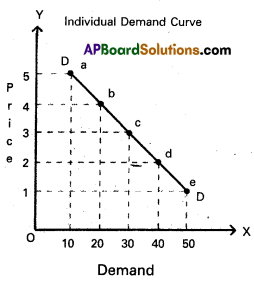
On OX axis shows demand, OY axis shows price. We can obtain the demand curve ‘DD’ by joining all the points A, B, C, D, E which represents various quantities of demand at various prices. ‘DD’ is demand curve. It slopes downwards from left to right. It shows the inverse relationship between price and demand.
2) Income demand: It explains the relationship between consumers income and various quantities of various levels of income assuming other factors like price of goods, related goods, taste etc; remain the same. It means if income increases quantity demand increases and vice versa. This can be shown in the following form.
Dx = f(Y)
The functional relationship between income and demand may be inverse or direct depending on the nature of the commodity. This can be shown in the following table.
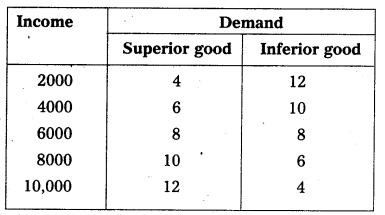
Superior goods : In case of superior goods quantity demanded will increase when there is an increase in the income of consumers.
In the diagram ‘X’ axis represents demand, OY axis represents income, YD represents the income demand curve. It showing positive slope whenever income increased from OY to OY1; the demand of superior or normal goods increases from OQ to OQ1.
This may happens in case of Veblen goods.
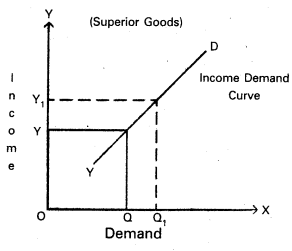
Inferior goods : On the contrary quantity demanded of inferior goods decreases with the increase in incomes of consumers.
In the diagram on ‘OX’ axis measures demand and OY axis represents income of the consumer. When the consumer income increases from OY to OY1 the demand for a commodity decreases from OQ to OQ1 So the YD’ curve is negative sloping.
3) Cross demand: Cross demand refers to the relationship between any two goods which are either complementary to each other or substitute for each other. It explains the functional relationship between the price of one commodity and quantity demanded of another commodity is called cross demand.
Dx = f(Py)
Where Dx – demand for ‘X’ commodity
Py Price of Y’ commodity
f = function
Substitutes : The goods which satisfy the same want are called substitutes.
Ex : Tea and coffee; pepsi and coca-cola etc. In the case of substitutes, the demand curve has a positive slope.
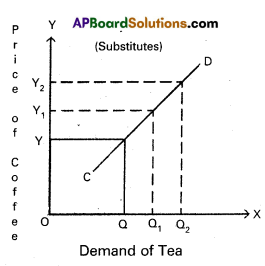
In the diagram ‘OX’ axis represents demand tea and OY axis represents price of coffee. Increase in the price of coffee from OY to OY2 leads to increase in the demand of tea from OQ to OQ2.
Complementaries : In case of complementary goods, with the increase in price of one commodity, the quantity demanded of another commodity falls.
Ex : Car and Petrol. Hence the demand curve of these goods slopes downward to the right.
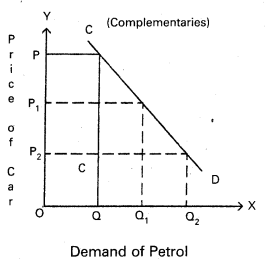
In the diagram if price of car decreases from OP to OP2 the quantity demand of petrol increases from OQ to OQ2. So cross demand i.e., CD curve is downward slopes.
![]()
Question 5.
Define the Concept of Elasticity of Demand and explain the concepts of price, income and cross elasticity of demand.
Answer:
The concept of elasticity demand was first introduced by Cournot and Mill. Later it was developed in a scientific manner by Marshall. Elasticity of demand means the degree of sensitiveness or responsiveness of demand to a change in its price.
According to Marshall “The elasticity of demand in a market is great or small according as the amount demanded increases much or little for a given fall in price”.
The concept of elasticity of demand explains how much or to what extent a change in any one of the independent variables leads to change in the dependent variable.
There are three kinds of elasticity of demand.
- Price elasticity of demand
- Income elasticity of demand
- Cross elasticity of demand
1) Price Elasticity of Demand : Alfred Marshall developed the concept of price elasticity of demand. Price elasticity of demand is generally defined as the degree of responsiveness or sensitiveness of demand for a commodity to the changes in its price. Thus price elasticity of demand is the ratio of percentage change in quantity demanded of a good and percentage change in its price. The following formula to measure price elasticity of demand.
Ep = \(\frac{\text { Percentage change in quantity demanded }}{\text { Percentage change in price }}\)
= \(\frac{\text { Change in quantity demanded }}{\text { Original quantity demanded }} \times \frac{\text { Original price }}{\text { Change in price }}\)
= \(\frac{\Delta \mathrm{q}}{\mathrm{q}} \times \frac{\mathrm{p}}{\Delta \mathrm{p}}=\frac{\Delta \mathrm{q}}{\Delta \mathrm{p}} \times \frac{\mathrm{p}}{\mathrm{q}}\)
where q = quantity;
p = price;
∆q = change in quantity demanded;
∆p = change in price.
There are five kinds of price elasticity of demand. They are :
- Perfectly Elastic demand (Ed = α)
- Perfectly Inelastic demand (Ed = 0)
- Unitary Elastic demand (Ed = 1)
- Relatively Elastic demand (Ed > 1)
- Relatively Inelastic demand (Ed < 1)
2) Income Elasticity of Demand : Income elasticity of demand shows the degree of responsiveness of quantity demanded of a commodity to a change in the income of the consumer, other things remain constant.
Ey = \(=\frac{\text { Percentage change in quantity demanded }}{\text { Percentage change inconsumer’s income }}\)
= \(=\frac{\text { Change in quantity demanded }}{\text { Original quantity demanded }} \times \frac{\text { Original income }}{\text { Change in income }}\)
= \(\frac{\Delta \mathrm{q}}{\mathrm{q}} \times \frac{\mathrm{y}}{\Delta \mathrm{y}}=\frac{\Delta \mathrm{q}}{\Delta \mathrm{y}} \times \frac{\mathrm{y}}{\mathrm{q}}\)
where q = Quantity;
y = income;
∆Q = change in quantity demanded;
∆y = change in income.
Income elasticity of demand will be positive in case of superior goods like milk and meat and negative in case of inferior goods like porridge and broken rice.
3) Cross Elasticity of Demand : Cross elasticity of demand refers to change in the quantity demanded of one good in response to change in the price of related good, other things remaining constant. There are certain goods whose demand depend not only to their price but also on the prices of related goods.
Ec = \(\frac{\text { Percentage change in quantity demanded of X }}{\text { Percentage change in the price of } Y}\)
Ec = \(\frac{\Delta \mathrm{Qx}}{\mathrm{Qx}} \div \frac{\Delta \mathrm{Py}}{\mathrm{Py}}=\frac{\Delta \mathrm{Qx}}{\mathrm{Qx}} \times \frac{\mathrm{Py}}{\Delta \mathrm{Py}}=\frac{\Delta \mathrm{Qx}}{\Delta \mathrm{Px}} \times \frac{\mathrm{Py}}{\mathrm{Px}}\)
Where Q(x) = Quantity demanded for X; P(y) = price of commodity (Y), ∆Q(x) = change in quantity demanded of X commodity, ∆P(y) = change in price of commodity Y.
Substitute goods like tea and coffee have positive cross elasticity demand where as complementary goods like shoes and socks have negative cross elasticity of demand.
![]()
Question 6.
What is Price Elasticity of Demand ? Explain the various types of Price Elasticity of Demand.
Answer:
Alfred Marshall developed the concept of price elasticity of demand. Price elasticity measures, other things remaining constant, change in the demanded of a good in response to a change in its price. Thus price elasticity of demand is the ratio of percentage change in quantity demanded of a good and percentage change in its price. Price elasticity can be written as stated below.
Ep = \(\frac{\text { Percentage change in quantity demanded }}{\text { Percentage change in price }}\)
= \(\frac{\text { Change in demand }}{\text { Original demand }} \times \frac{\text { Original price }}{\text { Change in price }}\)
= \(\frac{\Delta \mathrm{q}}{\mathrm{q}} \times \frac{\mathrm{p}}{\Delta \mathrm{p}}=\frac{\Delta \mathrm{q}}{\Delta \mathrm{p}} \times \frac{\mathrm{p}}{\mathrm{q}}\)
Where q = quantity; p = price; ∆q = change in demand; ∆p = change in price
Types of price elasticity of demand : Based on numerical value, price elasticity of demand can be five types.
- Perfectly Elastic demand (Ed = ∞)
- Perfectly Inelastic demand (Ed = 0)
- Unitary Elastic demand (Ed = 1)
- Relatively Elastic demand (Ed > 1)
- Relatively Inelastic demand (Ed < 1)
1) Perfectly Elastic demand : It is also known as “infinite elastic demand”. A small change in price leads to an infinite change in demand is called perfectly elastic demand. It is horizontal straight line to ‘X’ axis. The numerical value of perfectly elastic demand is infinite (Ed = ∞). It can be shown in the diagram.
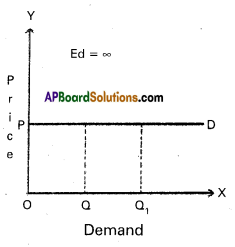
In the diagram, Ed = \(\frac{\mathrm{OQQ}_1}{\mathrm{OQ}} \div \frac{\mathrm{O}}{\mathrm{OP}}\)
= \(\frac{\mathrm{QQ}_1}{\mathrm{OQ}} \times \frac{\mathrm{OP}}{\mathrm{O}}\) = ∞
2) Perfectly Inelastic demand: It is also known as “zero elastic demand”. In this case even a great rise ‘or fall in price does not lead to any change in quantity demanded is known as perfectly inelastic demand. The ‘demand curve will be vertical to the Y axis. The numerical value is ‘OE. This can be shown in the following diagram.
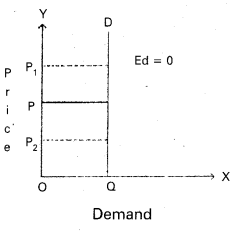
In the diagram, Ed = \(\frac{\text { Zero }}{\mathrm{OQ}} \div \frac{\mathrm{PP}_1}{\mathrm{OP}}\) = 0
∴ Ed = 0
3) Unitary Elastic demand: The percentage change in price leads to same percentage change in demand is called unitary elastic demand. In this case the elasticity of demand is equal to one. The shape of demand curve is “Rectangular Hyperbola”. This can be shown in the following.
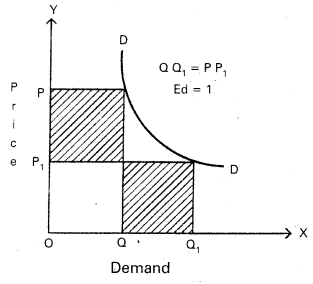
In the diagram, Ed = OP1Q1 = OPQ
(or) OQ1 = PP1
∴ Ed = 1
4) Relatively Elastic demand: When a percentage change in price leads to more than percentage change in quantity demand is called relatively elastic demand. In this case the numerical value of Ed is greater than one (Ed > 1)
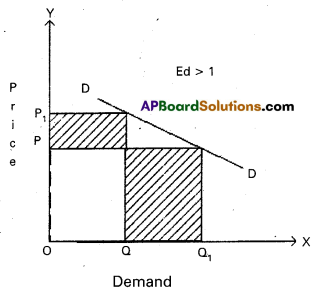
In the diagram, Ed = OQ1 > PP1
∴ Ed > 1
5) Relatively Inelastic demand : When the percentage change in price leads to a less than percentage change in quantity demand is called relatively inelastic demand. Here the numerical value is less than one (Ed < 1) . This can be shown to following diagram.
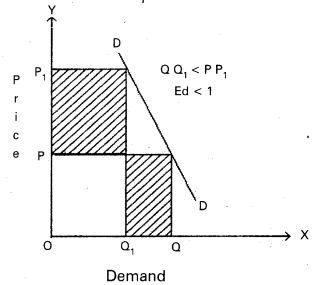
In the diagram, Ed = QQ1 < PP1
∴ Ed < 1
Question 7.
Explain the three methods of Measuring Price Elasticity of Demand.
Answer:
The concept of elasticity of demand is one of the original contributions of Dr.Marshall. The concepts of elasticity of demand clearly explains ‘how much’ demand increases due to a certain fall in price and ‘how much’ demand decreases due to certain rise in price.
According to Mrs. Joan Robinson, “The elasticity of demand at any price or at any output is the proportional change of amount purchased in response to a small change in price, divided by the proportional change in price”.
Methods of measurements of Price Elasticity of demand :
The Elasticity of demand can be measured mainly in three ways.
- Total outlay (or) Expenditure method
- Point method and
- Arc method.
1) Total outlay (or) Expenditure method : This method was introduced by Alfred Marshall. Price elasticity of demand can be measured on the basis of change in the total outlay due to a change in the price of a commodity. This method helps us to compare the total expenditure from a buyer or total revenue from the seller before and after the change in price.
Total outlay = Price × Quantity demanded
According to this method the price elasticity of demand is expressed in three forms, they are elastic demand, unitary elastic and inelastic demand. This can be explained with the help of table.
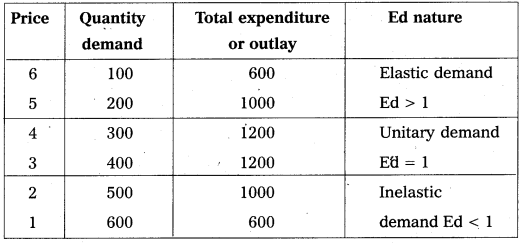
In this table shows that
- If the total expenditure increases due to a fall in price is known as relatively elastic demand.
- If total expenditure remains constant even the price falls is known as unitary elastic demand.
- If the total expenditure decreases due to a fall in price is known as relatively inelastic demand.
2) Point method : This method is introduced by Marshall. In this method elasticity of demand is measured at a point on the demand curve. So, this method is also called as “geometrical method”. In this method to measure elasticity at a point on demand curve the following formula is applied.
Ed = \(\frac{\text { The distance from the point to the } \mathrm{X} \text {-axis }}{\text { The distance from the point to the } \mathrm{Y} \text {-axis }}\)
In the below diagram ‘AE’ is straight line demand curve. Which is 10 cm length. Applying the formula we get
Ed = 1 Ed < 1 Ed = 0
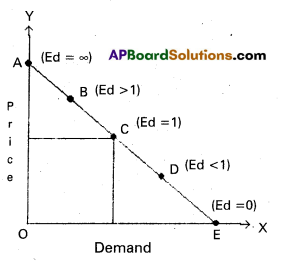
Elasticity at point A, Ed = \(\frac{\mathrm{AE}}{\mathrm{A}}=\frac{10}{0}\) = 0
Elasticity at point B, Ed = \(\frac{\mathrm{BE}}{\mathrm{BA}}=\frac{7.5}{2.5}\) = 3 > 1
Elasticity at point C, Ed = \(\frac{\mathrm{CE}}{\mathrm{CA}}=\frac{5}{5}\) = 1
Elasticity at point D, Ed = \(\frac{\mathrm{DE}}{\mathrm{DA}}=\frac{1}{3}\) = < 1
Elasticity at point E, Ed = \(\frac{\mathrm{E}}{\mathrm{DA}}=\frac{0}{10}\) = 0
if the demand curve is non-linear. It means if the demand curve is not straight line will be drawn at the point on the demand curve where to measure elasticity.
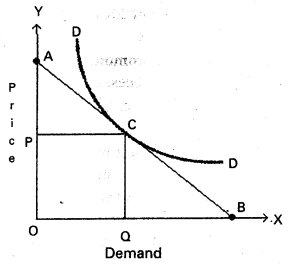
In the diagram at C point where Elasticity of demand will be equal to \(\frac{\mathrm{CB}}{\mathrm{CA}}\).
3) Arc method : The word ‘ArC means a portion or a segment of a demand curve. In this method mid points between the old and new price and quantities demanded are used. This method used to known small changes in price. This method is also known as ‘Average Elasticity of demand”. This method studies a segment of the demand curve between two points the formula for measuring elasticity is given below.

Suppose we take price of the commodity is ₹ 4/- demand is 300 units. If price falls ₹ 3/ – demand increases 400 units.
Then applying above formula Arc elasticity of demand is
\(\frac{100}{300+400} \div \frac{1}{4+3}=\frac{100}{700} \div \frac{1}{7}\)
= \(\frac{100}{700} \times \frac{7}{1}=\frac{700}{700}\) = 1
∴ Ed = 1
![]()
Question 8.
What are the factors that determine Price Elasticity of Demand ?
Answer:
The term elasticity refers to the measure of extent of relationship between two related variables. The elasticity of demand is the measure of responsiveness or sensitiveness of demand for a commodity to the change in it demand.
Determinants of Elasticity of Demand : The. elasticity of demand varies from commodity to commodity.
1) Nature of commodity: Commodities can be grouped as necessaries, comforts and luxuries. In case of necessaries, the elasticity of demand will be inelastic.
Ex : Rice, salt etc. On the other hand in case of luxuries the demand will be more elastic.
Ex : Diamonds & gold etc.
2) Availability of substitutes : Prices of substitutes influence the demand for a com-modity upto a certain extent. The closer the substitute, the greater the elasticity of demand for the commodity. For Ex : Cool drinks, soaps etc. but in case of non-availability of substitutes the elasticity of demand will be low.
3) Complementary goods: Price elasticity for a good is also depends on the nature of price elasticity of jointly demand goods. If the demand for car is elastic, then the demand for petrol will also be elastic.
4) Multiple uses of the commodity : The wider the range of alternative uses of a product, the higher the elasticity of demand and vice-versa.
Ex : Coal and electricity have multiple uses and will have elastic demand.
5) Proportion of income spent: If proportion of income spent on commodity is very small, its demand will be less elastic and vice-versa.
6) Period of time : In the long run, demand will be more elastic. Longer the time period considered, greater will be the possibility of substitution. For a cheaper good.
Ex : If the price of petrol increases in the short run, it may not be possible to replace the petrol engines with diesel engines but in the long run it can be possible.
7) Price level: Goods which are in very high range or in very low range have inelastic demand but it is high at moderate price.
8) Habit : The demand for a commodity to which the consumer is accustomed is generally inelastic.
Ex : Tobacco and alcohol.
9) Income group : The demand of higher income groups will be inelastic as they do not bother about price changes. On the other hand, the demand of middle and lower income groups will be elastic.
10) Postponement of purchase: The demand for a commodity, the consumption of which can be postponed is more eiastic than that of the use of the commodity cannot be postpone the purchases of such goods like life saving medicines.
![]()
Question 9.
Explain importance of Elasticity of Demand.
Answer:
The term elasticity refers to the measure of extent of relationship between two related variable. The elasticity of demand is the measure of responsiveness or sensitiveness of demand for a commodity to the change in it demand.
Importance :
1) Useful to monopolist: Monopolist should study the elasticity of demand for his commodity before fixing up the price. Monopolist will fix a higher price when the commodity inelastic demand, but he will fix a lower price when the commodity has elastic demand.
2) Useful to joint products : It is useful in the price fixation of joint goods like meat and fur. In such case the producer wall be guided by elasticity of demand to fix the prices of the joint goods.
3) Useful to the government: The concept of elasticity can be used in formulating government policies relating public utility service like Railways, drug industry etc.
4) Useful to international trade : In calculating the terms of trade both countries have to take into account the mutual elasticities of demand for the products.
5) Useful to finance minister : The concept of elasticity is useful to the Finance Minister in imposing taxes on goods. The finance minister studies the elasticity of commodities before he imposes new taxes or enhances old taxes.
6) Useful to Management: Before asking for higher wages trade union leaders must know the elasticity of demand of the product produced by them. Trade union leaders may demand for higher wages only when the goods produced by them have inelastic demand.
7) Useful to producers : Volume of goods must be produced in accordance with demand for the commodity. Whenever the demand for the commodity is inelastic, the producer will produce more commodities to take advantage of higher price. So, it helps in determining the volume of output.
Short Answer Questions
Question 1.
Explain the Law of Demand or Price Demand.
Answer:
Demand means a desire which is backed up by ability to buy and willingness to pay the price is called demand in Economics. Thus demand will be always to a price and time. Demand has the following features.
- Desire for the commodity
- Ability to buy the commodity
- Willing to pay the price of commodity
- Demand is always at a price ‘
- Demand is per unit of time i.e, per day, week etc.
Therefore the price demand may be expressed in the form of small equation.
Dx = f(Px)
Price demand explains the relation between price and quantity demanded of a commodity. Price demand states that there is an inverse relationship between price and demand.
Law of demand : Marshall defines the law of demand as, “The amount demanded increases with a fall in price and diminishes with arise in price when other things remain the same”. So, the law of demand explains the inverse relationship between the price and quantity demanded of a commodity.
Demand schedule : It means a list of the quantities demanded at various prices in a given period of time in a market. An imaginary example given below.
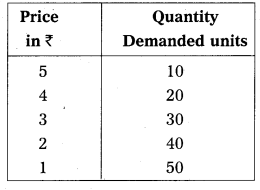
The table shows that as the price falls to ₹ 1/- the quantity demanded 50 units, when price ₹ 5/- he is buying 10 units. So, there is inverse relationship between price and demand. Price is low demand will be high and price is high demand will be low. We can illustrate the above schedule in a diagram.
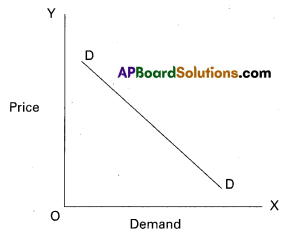
In the above diagram on X-axis demand is shown and price is on Y-axis. DD is the demand curve. Demand curves slopes downward from left to right.
Assumptions :
- No change in the income of consumer
- The taste and preferences consumers remain same.
- The prices of related goods remain the same.
- New substitutes are not discovered.
- No expectation of future price changes.
Exceptions : In certain situations, more will be demanded at higher price and less will be demanded at a lower price. In such cases the demand curve slopes upward from left to right which is called an exceptional demand curve. This can be shown in the following diagram.

In the diagram when price increases from OP to OP1, demand also increases from OQ to OQ1. This is opposite to law of demand.
![]()
Question 2.
Explain the Exceptions to the Law of Demand or Price Demand.
Answer:
In Economics demand means a desire which is backed up by ability to buy and willingness to pay the price. Thus demand will be always at a price and time.
According to Marshal “The amount demanded increases with a fall in price and diminishes with rise in price when other things remain the same”.
Exceptions : In certain situations, more will be demanded at higher price and less will be demanded at a lower price. In such cases the demand curve slopes upward from left to right which is called an exceptional demand curve. This can be shown in the following diagram.
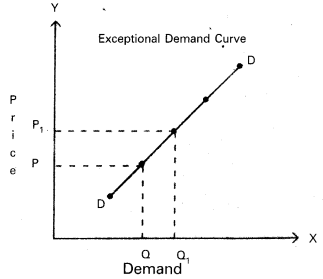
In the diagram when price increases from OP to OP1, demand also increases from OQ to OQ1. This is opposite to law of demand.
Question 3.
Why a Demand Curve has a negative slope or why Demand Curve slopes downward ? [March 18]
Answer:
According to Marshall “The amount demanded increases with a fall in price and diminishes with a rise in price when other things remain the same”.
The law of demand explains inverse relationship between the price and quantity demanded of a commodity. Therefore the demand curve slopes downward from left to right.
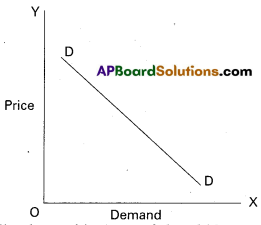
There are some other reasons also responsible for downward sloping demand curve.
1) Old and new buyers : If the price of a good falls, the real income of the old buyers will increase. Hence the demand for the good will increase. In the same way, the fall in price attracts new buyers and will be able to built after a fall in its price. So the demand curve slopes downards from left to right.
2) Income effect: Fall in price of commodity the real income of its consumers increase. The increase in real income encourages demand for the commodity with reduced price. The increase in demand on account of increased in real income is known as income effect.
3) Substitution effect: When the price of commodity falls, it will become relatively cheaper than its substitutes. The increase in demand on account of increased in real income is known as income effect.
4) Law of diminishing marginal utility: According to this law, if consumer goes on consuming more units of the commodity, the additional utility goes on diminishing. Therefore, the consumer prefers to buy at a lower price. As a result the demand curve has a negative slope.
![]()
Question 4.
Explain the concept of Income Demand.
Answer:
Income demand : It explains the relationship between consumers income and various quantities of various levels of income assuming other factors like price of goods, related goods, taste etc; remain the same. It means if income increases quantity demand increases and vice versa. This can be shown in the following form.
Dx = f(Y)
The functional relationship between income and demand may be inverse or direct depending on the nature of the commodity. This can be shown in the following table.
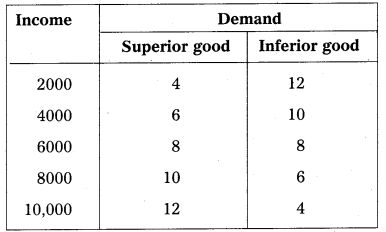
Superior goods : In case of superior goods quantity demanded will increase when there is an increase in the income of consumers.
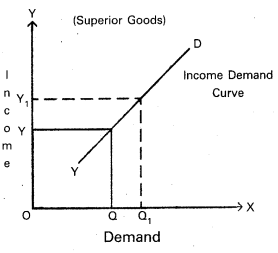
In the diagram ‘X’ axis represents demand, OY axis represents income, YD represents the income demand curve. It showing positive slope whenever income increased from OY to OY1 the demand of superior or normal goods increases from OQ to OQ1.
This may happens in case of Veblen goods.
Inferior goods : On the contrary quantity demanded of inferior goods decreases with the increase in incomes of consumers.
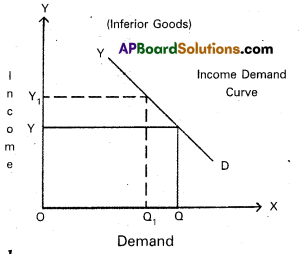
In the diagram on ‘OX’ axis measures demand and OY axis represents income of the consumer. When the consumer income increases from OY to OY1 the demand for a commodity decreases from OQ to OQ1 So the YD’ curve is negative sloping.
Question 5.
Explain the concept of Cross Demand.
Answer:
Cross demand: Cross demand refers to the relationship between any two goods which are either complementary to each other or substitute for each other. It explains the functional relationship between the price of one commodity and quantity demanded of another commodity is called cross demand.
Dx = f(Py)
Where Dx = demand for ‘X’ commodity
Px = Price of ‘y’ commodity
f = function
Substitutes : The goods which satisfy the same want are called substitutes.
Ex : Tea and coffee; pepsi and coca-cola etc. In the case of substitutes, the demand curve has a positive slope.
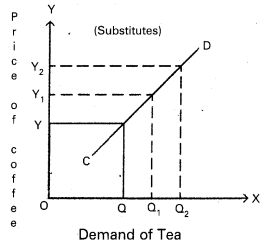
In the diagram ‘OX’ axis represents demand of tea and OY axis represents price of coffee. Increase in the price of coffee from OY to OY2 leads to increase in the demand of tea from OQ to OQ2.
Complementaries: In case of complementary goods, with the increase in price of one commodity, the quantity demanded of another commodity falls.
Ex : Car and Petrol. Hence the demand curve of these goods slopes downward to the right.
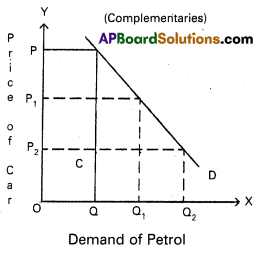
In the diagram if price of car decreases from OP to OP2 the quantity demand of petrol increases from OQ to OQ2. So cross demand i.e., CD curve is down ward slopes.
![]()
Question 6.
What are the factors that determine Demand ? [March 18, 17]
Answer:
The functional relationship between the demand for a commodity and its various determinants may be explained mathematically in terms of a demand function.
Dx = f(Px,P1, ………… Pn, Y, T)
Where Dx = Demand for good X;
Px = price of X;
P1 …. Pn = Prices of substitutes and complementaries
Y = Income,
T = Taste of the consumer.
Determinants of demand :
1) Price of commodity: The demand for any good depends on its price, more will be demanded at lower price and vice-versa.
2) Prices of substitutes and complementaries : Demand is influenced by changes in price of related goods either substitutes or complementary goods.
Ex: Increase in the price of coffee leads an increase in the demand for tea in the case of substitutes positive relation and complementaries negative relationship between price and demand.
3) Income of the consumer : Demand always changes with a change in the incomes of the people. When income increases the demand for several commodities increases and vice-versa.
4) Population : A change in the size and composition of population will effect the demand for certain goods like food grains, clothes etc.
5) Taste and preferences: A change in the taste and the fashions bring about a change in the demand for a commodity.
6) Technological changes: Due to economic progress technological changes the quantity the quality of goods available to the consumers increase.
Ex : Demand for cell phones reduced the demand for landline phones.
7) Change in the weather : Demand for commodity may change due to change in a climatic condition.
Ex : During summer demand for cool drinks, in winter demand for wollen clothes.
8) State of business : During the period of prosperity demand for commodities will expand and during depression demand will contract.
Question 7.
What is Elasticity of Demand ?
Answer:
In Economic theory, the concept of elasticity of demand has a significant role. Elasticity of demand means the percentage change in quantity demanded in response to the percentage change in one of the variables on which demand depends.
Elasticity of demand changes from person to person, place to place, time to time and one commodity to another.
Accoridng to Marshall “The elasticity of demand in a market is great or small according as the amount demanded increases much or little for a given fall in price”.
The concept of elasticity of demand explains how much or to what extent a change in any one of the independent variables leads to a change in the dependent variable.
There are three kinds of elasticity of demand.
- Price Elasticity of demand
- Income Elasticity of demand .
- Cross Elasticity of demand
![]()
Question 8.
Explain the three types of Elasticity of Demand.
Answer:
The concept of elasticity demand was first introduced by Cournot and Mill. Later it was developed in a scientific manner by Marshall. Elasticity of demand means the degree of sensitiveness or responsiveness of demand to a change in its price.
According to Marshall “The elasticity of demand in a market is great or small according as the amount demanded increases much or little for a given fall in price”.
The concept of elasticity of demand explains how much or to what extent a change in any one of the independent variables leads to change in the dependent variable.
There are three kinds of elasticity of demand.
- Price elasticity of demand
- Income elasticity of demand
- Cross elasticity of demand
1) Price Elasticity of Demand : Alfred Marshall developed the concept of price elasticity of demand. Price elasticity of demand is generally defined as the degree of responsiveness or sensitiveness of demand for a commodity to the changes in its price. Thus price elasticity of demand is the ratio of percentage change in quantity demanded of a good and percentage change in its price. The following formula to measure price elasticity of demand.
Ep = \(\frac{\text { Percentage change in quantity demanded }}{\text { Percentage change in price }}\)
= \(\frac{\text { Change in quantity demanded }}{\text { Original quantity demanded }} \times \frac{\text { Original price }}{\text { Change in price }}\)
= \(\frac{\Delta \mathrm{q}}{\mathrm{q}} \times \frac{\mathrm{p}}{\Delta \mathrm{p}}=\frac{\Delta \mathrm{q}}{\Delta \mathrm{p}} \times \frac{\mathrm{p}}{\mathrm{q}}\)
where q = quantity;
p = price;
∆q = change in quantity demanded;
∆p = change in price.
There are five kinds of price elasticity of demand. They are :
- Perfectly Elastic demand (Ed = α)
- Perfectly Inelastic demand (Ed = 0)
- Unitary Elastic demand (Ed = 1)
- Relatively Elastic demand (Ed > 1)
- Relatively Inelastic demand (Ed < 1)
2) Income Elasticity of Demand : Income elasticity of demand shows the degree of responsiveness of quantity demanded of a commodity to a change in the income of the consumer, other things remain constant.
Ey = \(=\frac{\text { Percentage change in quantity demanded }}{\text { Percentage change inconsumer’s income }}\)
= \(=\frac{\text { Change in quantity demanded }}{\text { Original quantity demanded }} \times \frac{\text { Original income }}{\text { Change in income }}\)
= \(\frac{\Delta \mathrm{q}}{\mathrm{q}} \times \frac{\mathrm{y}}{\Delta \mathrm{y}}=\frac{\Delta \mathrm{q}}{\Delta \mathrm{y}} \times \frac{\mathrm{y}}{\mathrm{q}}\)
where q = Quantity;
y = income;
∆Q = change in quantity demanded;
∆y = change in income.
Income elasticity of demand will be positive in case of superior goods like milk and meat and negative in case of inferior goods like porridge and broken rice.
3) Cross Elasticity of Demand : Cross elasticity of demand refers to change in the quantity demanded of one good in response to change in the price of related good, other things remaining constant. There are certain goods whose demand depend not only to their price but also on the prices of related goods.
Ec = \(\frac{\text { Percentage change in quantity demanded of X }}{\text { Percentage change in the price of } Y}\)
Ec = \(\frac{\Delta \mathrm{Qx}}{\mathrm{Qx}} \div \frac{\Delta \mathrm{Py}}{\mathrm{Py}}=\frac{\Delta \mathrm{Qx}}{\mathrm{Qx}} \times \frac{\mathrm{Py}}{\Delta \mathrm{Py}}=\frac{\Delta \mathrm{Qx}}{\Delta \mathrm{Px}} \times \frac{\mathrm{Py}}{\mathrm{Px}}\)
Where Q(x) = Quantity demanded for X; P(y) = price of commodity (Y), ∆Q(x) = change in quantity demanded of X commodity, ∆P(y) = change in price of commodity Y.
Substitute goods like tea and coffee have positive cross elasticity demand where as complementary goods like shoes and socks have negative cross elasticity of demand.
![]()
Quantity 9.
Define Price Elasticity of Demand. Explain briefly various types of Price Elasticity of Demand.
Answer:
Alfred Marshall developed the concept of price elasticity of demand. Price elasticity measures, other things remaining constant, change in the demanded of a good in response to a change in its price. Thus price elasticity of demand is the ratio of percentage change in quantity demanded of a good and percentage change in its price. Price elasticity can be written as stated below.
Ep = \(\frac{\text { Percentage change in quantity demanded }}{\text { Percentage change in price }}\)
= \(\frac{\text { Change in demand }}{\text { Original demand }} \times \frac{\text { Original price }}{\text { Change in price }}\)
= \(\frac{\Delta \mathrm{q}}{\mathrm{q}} \times \frac{\mathrm{p}}{\Delta \mathrm{p}}=\frac{\Delta \mathrm{q}}{\Delta \mathrm{p}} \times \frac{\mathrm{p}}{\mathrm{q}}\)
Where q = quantity; p = price; ∆q = change in demand; ∆p = change in price
Types of price elasticity of demand : Based on numerical value, price elasticity of demand can be five types.
- Perfectly Elastic demand (Ed = ∞)
- Perfectly Inelastic demand (Ed = 0)
- Unitary Elastic demand (Ed = 1)
- Relatively Elastic demand (Ed > 1)
- Relatively Inelastic demand (Ed < 1)
1) Perfectly Elastic demand : It is also known as “infinite elastic demand”. A small change in price leads to an infinite change in demand is called perfectly elastic demand. It is horizontal straight line to ‘X’ axis. The numerical value of perfectly elastic demand is infinite (Ed = ∞). It can be shown in the diagram.

In the diagram, Ed = \(\frac{\mathrm{OQQ}_1}{\mathrm{OQ}} \div \frac{\mathrm{O}}{\mathrm{OP}}\)
= \(\frac{\mathrm{QQ}_1}{\mathrm{OQ}} \times \frac{\mathrm{OP}}{\mathrm{O}}\) = ∞
2) Perfectly Inelastic demand: It is also known as “zero elastic demand”. In this case even a great rise ‘or fall in price does not lead to any change in quantity demanded is known as perfectly inelastic demand. The ‘demand curve will be vertical to the Y axis. The numerical value is ‘OE. This can be shown in the following diagram.

In the diagram, Ed = \(\frac{\text { Zero }}{\mathrm{OQ}} \div \frac{\mathrm{PP}_1}{\mathrm{OP}}\) = 0
∴ Ed = 0
3) Unitary Elastic demand: The percentage change in price leads to same percentage change in demand is called unitary elastic demand. In this case the elasticity of demand is equal to one. The shape of demand curve is “Rectangular Hyperbola”. This can be shown in the following.

In the diagram, Ed = OP1Q1 = OPQ
(or) OQ1 = PP1
∴ Ed = 1
4) Relatively Elastic demand: When a percentage change in price leads to more than percentage change in quantity demand is called relatively elastic demand. In this case the numerical value of Ed is greater than one (Ed > 1)

In the diagram, Ed = OQ1 > PP1
∴ Ed > 1
5) Relatively Inelastic demand : When the percentage change in price leads to a less than percentage change in quantity demand is called relatively inelastic demand. Here the numerical value is less than one (Ed < 1) . This can be shown to following diagram.

In the diagram, Ed = QQ1 < PP1
∴ Ed < 1
![]()
Question 10.
Explain the Total Outaly method of Measuring Elasticity of Demand.
Answer:
Total Outlay (or) Expenditure method : This method was introduced by Alfred Marshall. Price elasticity of demand can be measured on the basis of change in the total outlay due to a change in the price of a commodity. This method helps us to compare the total expenditure from a buyer or total revenue from the seller before and after the change in price.
Total outlay = Price × Quantity demanded
According to this method the price elasticity of demand is expressed in three forms, they are elastic demand, unitary elastic and inelastic demand. This can be explained with the help of table.
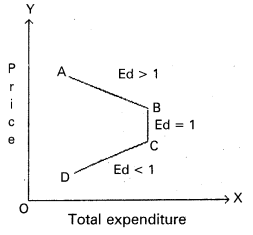
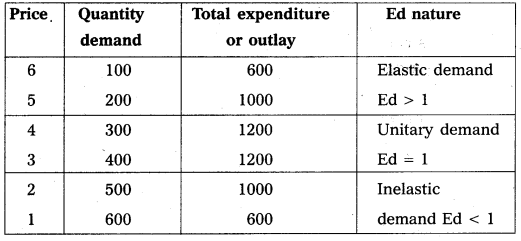
In this table shows that
- If the total expenditure increases due to a fall in price is known as relatively elastic demand.
- If total expenditure remains constant even the price falls is known as unitary elastic demand.
- If the total expenditure decreases due to a fall in price is known as relatively inelastic demand.
In the diagram on ‘OX’ axis measure total expenditure and ‘OY axis measures price. The total outlay curve AD is shown in three parts i.e., A to B; B to C and C to D.
Question 11.
Explain the Point method of Measuring Price Elasticity of Demand or How do you measure Elasticity of Demand on straight line Demand Curve ?
Answer:
Point method : This method is introduced by Marshall. In this method elasticity of demand is measured at a point on the demand curve. So, this method is also called as “geometrical method”. In this method to measure elasticity at a point on demand curve the following formula is applied.
Ed = \(\frac{\text { The distance from the point to the } \mathrm{X} \text {-axis }}{\text { The distance from the point to the } \mathrm{Y} \text {-axis }}\)
In the below diagram ‘AE’ is straight line demand curve. Which is 10 cm length. Applying the formula we get
Ed = 1 Ed < 1 Ed = 0
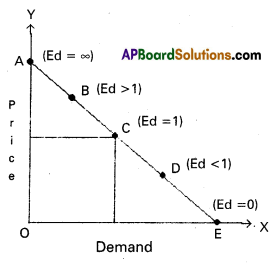
Elasticity at point A, Ed = \(\frac{\mathrm{AE}}{\mathrm{A}}=\frac{10}{0}\) = 0
Elasticity at point B, Ed = \(\frac{\mathrm{BE}}{\mathrm{BA}}=\frac{7.5}{2.5}\) = 3 > 1
Elasticity at point C, Ed = \(\frac{\mathrm{CE}}{\mathrm{CA}}=\frac{5}{5}\) = 1
Elasticity at point D, Ed = \(\frac{\mathrm{DE}}{\mathrm{DA}}=\frac{1}{3}\) = < 1
Elasticity at point E, Ed = \(\frac{\mathrm{E}}{\mathrm{DA}}=\frac{0}{10}\) = 0
If the demand curve is non-linear. It means if the demand curve is not straight line will be drawn at the point on the demand curve where to measure elasticity.
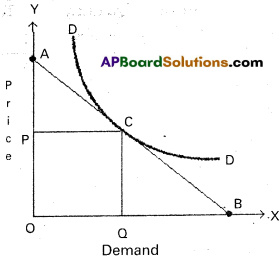
In the diagram at C point where Elasticity of demand will be equal to \(\frac{\mathrm{CB}}{\mathrm{CA}}\).
Question 12.
What are the basic determinants of Elasticity of Demand ?
Answer:
The term elasticity refers to the measure of extent of relationship between two related variables. The elasticity of demand is the measure of responsiveness or sensitiveness of demand for a commodity to the change in it demand.
Determinants of Elasticity of Demand : The. elasticity of demand varies from commodity to commodity.
1) Nature of commodity: Commodities can be grouped as necessaries, comforts and luxuries. In case of necessaries, the elasticity of demand will be inelastic.
Ex : Rice, salt etc. On the other hand in case of luxuries the demand will be more elastic.
Ex : Diamonds & gold etc.
2) Availability of substitutes : Prices of substitutes influence the demand for a com-modity upto a certain extent. The closer the substitute, the greater the elasticity of demand for the commodity. For Ex : Cool drinks, soaps etc. but in case of non-availability of substitutes the elasticity of demand will be low.
3) Complementary goods: Price elasticity for a good is also depends on the nature of price elasticity of jointly demand goods. If the demand for car is elastic, then the demand for petrol will also be elastic.
4) Multiple uses of the commodity : The wider the range of alternative uses of a product, the higher the elasticity of demand and vice-versa.
Ex : Coal and electricity have multiple uses and will have elastic demand.
5) Proportion of income spent: If proportion of income spent on commodity is very small, its demand will be less elastic and vice-versa.
6) Period of time : In the long run, demand will be more elastic. Longer the time period considered, greater will be the possibility of substitution. For a cheaper good.
Ex : If the price of petrol increases in the short run, it may not be possible to replace the petrol engines with diesel engines but in the long run it can be possible.
7) Price level: Goods which are in very high range or in very low range have inelastic demand but it is high at moderate price.
8) Habit : The demand for a commodity to which the consumer is accustomed is generally inelastic.
Ex : Tobacco and alcohol.
9) Income group : The demand of higher income groups will be inelastic as they do not bother about price changes. On the other hand, the demand of middle and lower income groups will be elastic.
10) Postponement of purchase: The demand for a commodity, the consumption of which can be postponed is more eiastic than that of the use of the commodity cannot be postpone the purchases of such goods like life saving medicines.
![]()
Question 13.
Explain the importance of the Concept of Elasticity of Demand.
Answer:
The term elasticity refers to the measure of extent of relationship between two related variable. The elasticity of demand is the measure of responsiveness or sensitiveness of demand for a commodity to the change in it demand.
Importance :
1) Useful to monopolist: Monopolist should study the elasticity of demand for his commodity before fixing up the price. Monopolist will fix a higher price when the commodity inelastic demand, but he will fix a lower price when the commodity has elastic demand.
2) Useful to joint products : It is useful in the price fixation of joint goods like meat and fur. In such case the producer wall be guided by elasticity of demand to fix the prices of the joint goods.
3) Useful to the government: The concept of elasticity can be used in formulating government policies relating public utility service like Railways, drug industry etc.
4) Useful to international trade : In calculating the terms of trade both countries have to take into account the mutual elasticities of demand for the products.
5) Useful to finance minister : The concept of elasticity is useful to the Finance Minister in imposing taxes on goods. The finance minister studies the elasticity of commodities before he imposes new taxes or enhances old taxes.
6) Useful to Management: Before asking for higher wages trade union leaders must know the elasticity of demand of the product produced by them. Trade union leaders may demand for higher wages only when the goods produced by them have inelastic demand.
7) Useful to producers : Volume of goods must be produced in accordance with demand for the commodity. Whenever the demand for the commodity is inelastic, the producer will produce more commodities to take advantage of higher price. So, it helps in determining the volume of output.
Very Short Answer Question
Question 1.
Demand
Answer:
The desire backed up by willingness and ability to pay a sum of money for some quantity of a good or service.
![]()
Question 2.
Demand Schedule [March 17]
Answer:
It shows the functional relationship between the quantity of commodity demanded and its price. The demand schedule may be two types.
- Individual demand schedule
- Market demand schedule
Question 3.
Individual Demand Schedule
Answer:
It explains the relationship between various quantities purchased at various prices by a single consumer in the market.
Question 4.
Market Demand Schedule
Answer:
It shows the total demand for a group at a particular time at different prices in the market.
Question 5.
Demand Function
Answer:
Demand function shows the functional relationship between quantity demanded at various factors that determine the demand for a commodity. It can be expressed as follows.
Dx = f(Px, P1, ………… Pn, Y, T)
Where
Dx = Demand for good X
Px = price of X
P1 …. Pn = Prices of substitutes and complementary
Y = Income of consumer
T = Tastes
f = Functional relationship
Question 6.
Giffen’s Paradox (or) Giffen Goods [March 18, 16]
Answer:
It means necessary goods Sir Robert Giffen in mid 19th century observed that the low paid workers in England purchased more bread when its price increase by decrease in the purchase of meat. The increase in demand for bread when price increased is an exception to the law of demand, it is known as Giffen’s paradox.
![]()
Question 7.
Veblen Goods (or) Prestigious Goods
Answer:
This is associated with the name of T.Veblen costly goods like diamonds and cars are called Veblen goods generally rich people purchase those goods. For the sake of prestage. Hence rich people may buy more such goods when their prises rise.
Question 8.
Speculation
Answer:
When the price of commodity rises the group of speculats except that be rise still further. Therefore, they buy more of the commodity. If they expect that there is a fallen price, the demand may not expand. Ex : shares.
Question 9.
Price Demand
Answer:
It explains the functional relationship between price of good and quantity of demanded when the remaining factors constant. It shows inverse relationship between price and demand.
Dx = f(Px)
Dx = Demand for X commodity
Px = Price of X
Question 10.
Income Demand [March 17]
Answer:
It shows the direct relationship between the income of the consumer and quantity demanded when the other factors remain constant. There is direct relationship between income and demand for superior goods. Inverse relationship between income and demand for inferior goods.
Dx = f(Y)
Question 11.
Cross Demand [March 18]
Answer:
Cross demand refers to the relationship between any two goods which are either complementary to each other or substitute of each other at different prices.
Dx = f(Py)
![]()
Question 12.
Substitutes
Answer:
These are goods which satisfy the same want.
Ex : tea and coffee. In this case the relationship between demand for a product and the price of its substitute is positive in its nature.
Question 13.
Complementaries
Answer:
These are goods which satisfy the same wants jointly.
Ex : Shoes and socks, car and petrol. The relationship between complementary goods is inverse.
Question 14.
Inferior Goods
Answer:
The goods whose income elasticity of demand is negative for levels of income are termed as inferior goods. In case of inferior goods if income increases demand decreases and vice-versa. The income demand for inferior goods has a negative slope.
Question 15.
Elasticity of Demand
Answer:
It means the degree of responsiveness of demand or the sensitiveness of demand to change in price. This was developed by Marshall It explains how much demand increases due to fall in price and how much demand decreases due to rise in price.
Question 16.
Price Elasticity of Demand
Answer:
It is the percentage change in quantity demanded of a commodity as a result of percentage change in price of a commodity.
Ed = \(\frac{\text { Percentage change in quantity demanded }}{\text { Percentage change in price }}\)
![]()
Question 17.
Income Elasticity of Demand
Answer:
It is the percentage change in quantity demanded of a commodity as a result of percentage change in the income of the consumer.
Ey = \(\frac{\text { Percentage change in quantity demanded }}{\text { Percentage change in consumer’s income }}\)
Question 18.
Cross Elasticity of Demand
Answer:
It is the percentage change in the quantity demanded of a commodity as a result of proportional change in the price of related commodity.
Ec = \(\frac{\text { Percentage change in quantity demanded of } \mathrm{X}}{\text { Percentage change in the price of } \mathrm{Y}}\)
Question 19.
Perfectly Elastic Demand
Answer:
If a negligible change in price leads to an infinite change in demand is called perfectly elastic demand. In this case the demand curve is horizontal to ‘X’ axis.
Question 20.
Perfectly Inelastic Demand [March 16]
Answer:
Even a great rise or fall in price does not lead and change in quantity demanded is known as perfectly inelastic demand. The demand curve is vertical to ‘Y’ axis.
Question 21.
Unitary Elastic Demand
Answer:
The proportionate change demand is equal to the proportionate change in price. In this case the demand curve will be a rectangular hyperbola.
![]()
Question 22.
Relatively Elastic Demand
Answer:
When a proportionate change in price leads to more than proportionate change in quantity demand is called relatively elastic demand.
Question 23.
Relatively Inelastic Demand
Answer:
When the proportionate change in price leads to a less than proportionate change in quantity demand is called relatively inelastic demand.
Question 24.
Arc method
Answer:
Arc method is the elasticity of the mid point of an arc of a demand curve. It studies a portion of the demand curve between two points. This is used when the change in price is not very large.
Question 25.
Importance of Price Elasticity of Demand.
Answer:
- It is useful to finance minister in imposing taxes.
- Useful to monopolist for fixing the price.
- Useful in determination of wages.
- Useful in determination of prices of factors of production.
Additional Questions
Question 26.
Terms of Trade
Answer:
It is the ratio of an index of a country’s export price to an index of its important price.
![]()
Question 27.
Tax
Answer:
Tax is a compulsory payment collected from individuals or firms by central, state and local governments.
